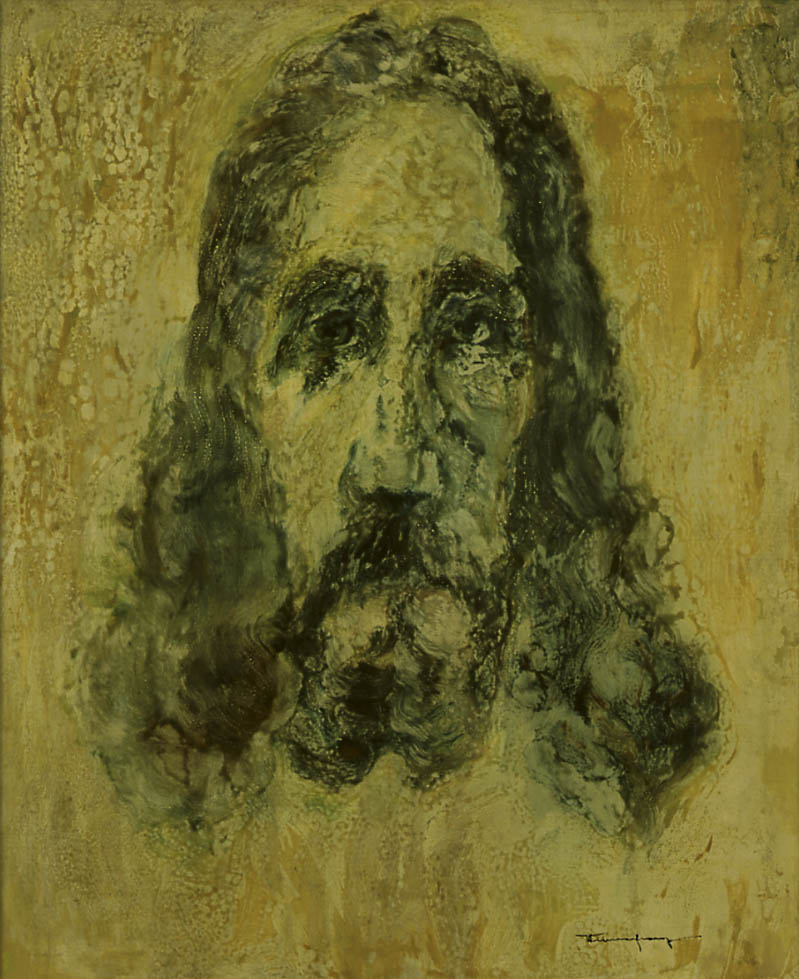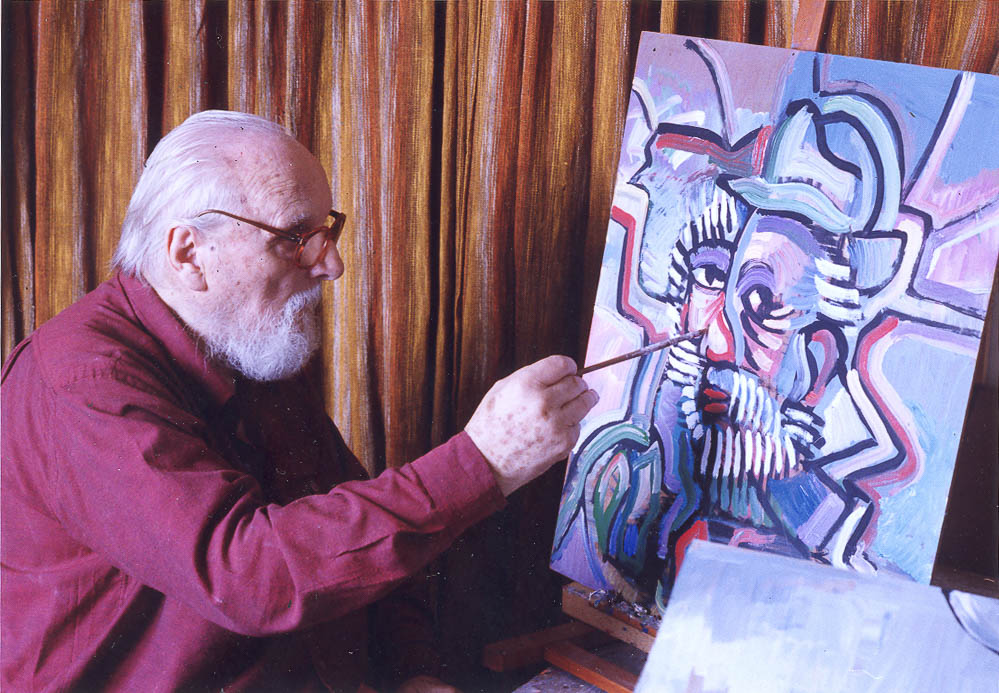
Franz Josef Widmar
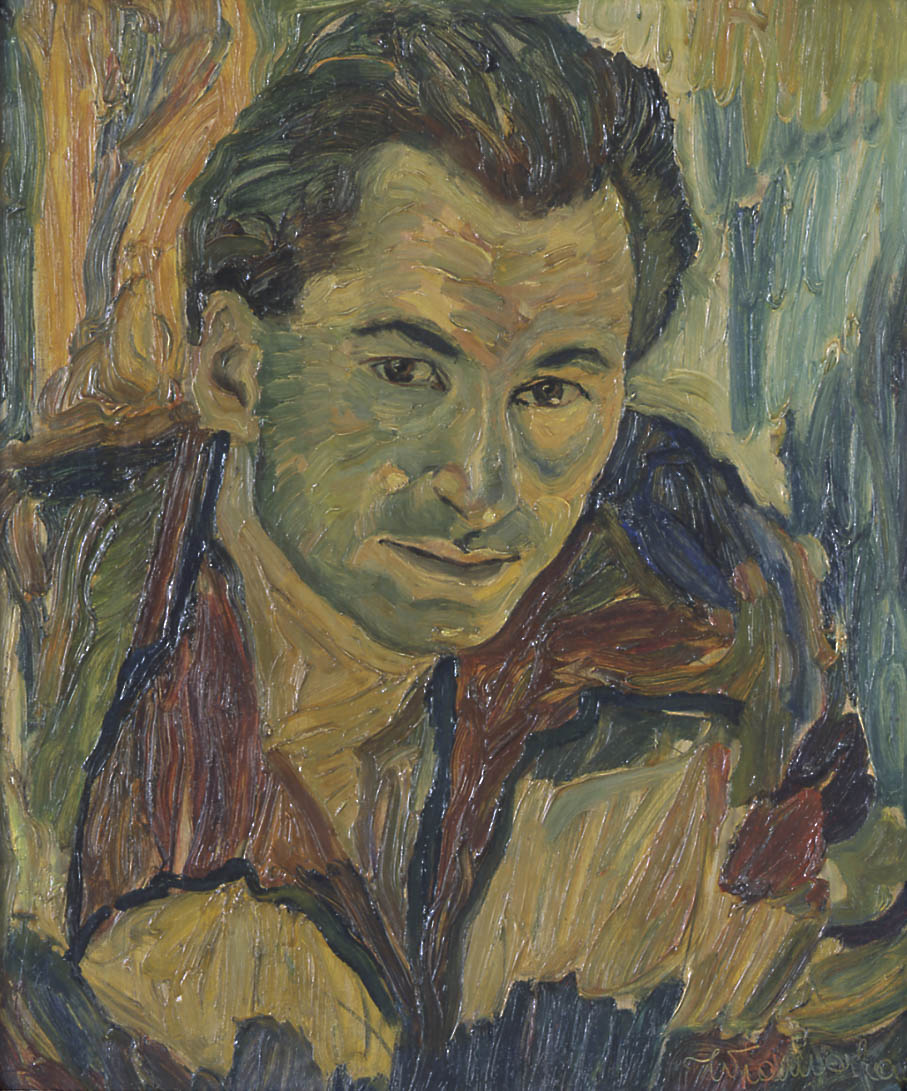
ohne Titel, Nr. 408, Öl auf Leinwand, 46 x 38 cm
The world‘s most extensive and clearly presented collection of paintings by the Austrian painter Franz Josef Widmar in a permanent exhibition forms the core of the Brasilea Foundation. Until now, there has been no comprehensive survey of the artist‘s more than 500 works. This publication is the first to present a large selection of paintings by Widmar from the Wüthrich Collection. It is meant to satisfy the need for a representative cross-section of the multifaceted oeuvre of Franz Josef Widmar while at the same time providing access to the Foundation‘s collection in order to promote the intensive and continuous study of a body of works that until now has enjoyed little recognition.
Any discussion of Franz Josef Widmar‘s artistic works necessarily raises the question of how to approach an oeuvre which at first sight does not have a recognizable personal style and which instead is primarily characterized by constant change from one style and genre to another. A survey of the collection of paintings is in some ways like a cross-section of the art history of the past 150 years. There is hardly a style that Widmar did not explore in the course of his artistic career, hardly a genre he was not interested in, hardly a technique he did not try his hand at. But when we attempt to understand the motivation of an artist or the basis for the artist‘s actions within a body of work, the first thing we do is try to identify constants, fixed elements that make it possible to establish a pattern that sheds light on his or her artistic development and technical and intellectual capacity. The concept that an artistic oeuvre has a ‚soul‘ is based on precisely these defining characteristics, which are inextricably tied to the artist‘s very being. In Widmar‘s case, such efforts are above all thwarted by the lack of constancy in his work as far as stylistic characteristics are concerned and by the sometimes marked discrepancy in the quality of his paintings.
Franz Josef Widmar does not appear to have been interested in the ephemeral pursuit of theoretical discourse, but instead was looking for an underlying truth – a truth that never claims universal validity, a truth that establishes the closest conceivable relationship between the artist and its manifold conditions. Widmar‘s artistic approach, which always corresponded with his very unique concept of what it means to be an artist, is closely tied to his general living situation. The constant financial support from a few friends seems to have made it possible for Franz Josef Widmar to get by with minimal, but sufficient, means. Nonetheless, it would be mistaken to claim that Widmar was nothing more than a commissioned painter. It appears that Widmar never paid much attention to his sometimes precarious economic situation. Throughout his life, he seems to have been content with the modest expectations of being able to paint and maintain a certain degree of freedom in this activity, but he never took these privileges for granted. In Rio de Janeiro, far from the cultural centres where art historic discourse is pursued with tremendous zeal and where artistic activities are increasingly relegated to an academic career, he was able to actualize his artistic vision.
Because we have hardly any concrete information on Widmar‘s (artistic) education, and because the earliest datable work in the collection is from the mid-1950s, it is hardly possible to determine whether Widmar ever adhered to a single style for an extended period. It is relatively easy to recognize the many different influences of various styles and eras in his work. What is far more complex, if not impossible, is any attempt to identify a hierarchy among these influences. Of course, some of his works are clearly inspired by Oskar Kokoschka and several other artists who were involved in the Vienna Secession and later in the Kunstschau group. Other paintings strongly recall Paul Klee or appear to draw very closely on the views espoused by the late Impressionists, to name just a few examples. Widmar‘s oeuvre is full of reminiscences, references, and borrowed styles. A list of the various different influences would inevitably read like a catalogue of artistic styles that could be arbitrarily expanded, or an enumeration of the most famous protagonists in painting in at least the last 150 years. But such an exercise would be self-serving at best and would contribute little to a deeper understanding of Widmar‘s oeuvre. The quantity and significance of the individual references make it seem obsolete to attempt to grasp his lifework with the aid of a hierarchically catalogued spectrum of various sources. In individual cases or in reference to isolated bodies of work such a methodology may well make sense, and it will in fact be addressed elsewhere. But in reference to his work as a whole, such an approach fails to do justice to the variety.
Instead, we need to accept the fact that for Widmar art history was a kind of ‚library of images‘. Every image – regardless of its artistic value – first and foremost represents an individual expectation of its author. An image, in other words, is the result of a task that a person takes on. It cannot have been Widmar‘s primary goal to develop his own style to the point that such style would have been his own, unmistakable in its visual appearance. He resorted to his own ‚library of images‘ the way others refer to a specific theory or a book for a certain task relating to a specific scientific theory. For Franz Widmar, the visualization of a definable, preconceived idea was primarily dependent on which style the artist would employ. The possibility of an artistic statement in a painting, then, was based on the range of stylistic potentials; for Widmar, the aspects of artistic talent, perception, and the inner conviction to find his own truth in the painting did not come into play until the second step. These various different levels can only be understood in a reciprocal relationship with each other, and it is only Widmar‘s tremendous talent that lends his paintings their genuine power of expression and a quality that can be far more than merely a reference. Such an approach is experimental in character by its very nature since an artistic practice founded on it always entails the repeated exploration of new territory. With these considerations in mind, we can more readily interpret the qualitative discrepancies in Widmar‘s oeuvre. The sometimes awkward quality in certain paintings is a result of the fact that Widmar was never satisfied and in the search for means of expression was never afraid to experiment with new styles and genres. The consequence, of course, is that not all paintings exhibit the same confidence in execution.
Widmar‘s artistic approach hardly corresponds to the conventional experience that the oeuvre of an artist ultimately represents a search for entirely unique strategies of representation. But this makes it all too easy to forget that after his emigration to Brazil Franz Josef Widmar worked in an environment that had very little in common with the artistic landscape in Europe and the US. Widmar absorbed the impressions and experiences from his time in Europe, and his work very clearly exhibits the lasting influence of his past. But it appears that the experimental character of his artistic activities can only be explained by the fact that in Brazil Widmar was not directly involved in ‚Western‘ discourse. In Rio, Widmar seems to have found the creative freedom that is so fundamental in his work. We hope this book will provide an impression of Widmar‘s tremendous creative diversity.

ohne Titel, Nr. 508, Öl auf Leinwand, 46 x 38 cm
THE OEUVRE OF THE PAINTER
FRANZ JOSEF WIDMAR
The lifework of this artist who was born in Austria and died in Brazil in 1995 has found a permanent home in the spacious cultural centre of the Brasilea Foundation in Basel‘s Rhine Harbour area. The 527 works, most of them painted in Pavatex, are presented in a clearly arranged exhibition on the first floor of the distinctive building. The works are grouped according to topics and are so multifaceted that they appear to have been painted by various artists. The stylistic and thematic variety is overwhelming.
Looking for the meaning of life
The progressive globalization of the world did not affect the intellectual vibrancy and formality of Franz Josef Widmar‘s paintings. Their delicate sensibility and light-heartedness illustrates the artist‘s constant search for truth and the meaning of life. In the solitude of his studio in Brazil, he strove for pristine nature and brought it to life with his confident brush stroke and ingenious colour compositions. His work manifests a fascinating journey into the world of memories – a yearning for freedom and social independence.
Friedrich von Schlegel (1772 to 1829) aptly said that in classic times we carried the centre of life within, and the inner balance and romanticism of Franz Josef Widmar‘s paintings may well reflect this maxim. They recall Runge, Corot, and Töpfer. In a various paintings, the artist depicts the impermanence of existence and the sufferings of Christ on the cross. He created striking portraits – including a number of self-portraits – with subtle brush strokes and skilful palette knife technique. Widmar was inspired by the style of Gaugin, Cézanne, van Gogh and Hodler. He also succeeded in translating the compositional arbitrariness of Japanese painting with its delicate play of colours to large, delightful flower paintings reminiscent of colour woodcuts by Harunobu or Hiroshige. Widmar‘s virtuoso representational games and the way he integrates surfaces into space – an approach employed by William Wauer in 1910 and later by Klee – demonstrate the influence of modern Constructivism. A poignant portrait of a woman recalls the colourful mosaics of Ravenna while other compositions recall Byzantine icons. They elicit the eternal nature of the human form and untouched landscapes.
Only the future will tell the true artistic value of this multifaceted oeuvre. Widmar‘s dynamic and confident style and his mastery of technique support the objective assessment of his importance. My personal opinion is that Franz Widmar was driven by an inner calling.
José Warmund-Cordelier
PORTRAIT
Portrait painting occupies an especially prominent position in Franz Josef Widmar‘s extensive oeuvre. Aside from landscape paintings, no other genre is represented as frequently as portraits. It is unclear whether the artist‘s strong focus on the human subject was mainly a result of his patrons‘ expectations and needs or a special affinity for the representation of individuals. But there is no question that Widmar considered the representation of persons to be a principal element in his art.
Even the very limited number of portraits selected here from among this body of works visibly demonstrates the tremendous variety of styles. The stylistic heterogeneity is of course not limited to the portraits, but it is especially apparent in this genre due to the tremendous quantity of this type of works.
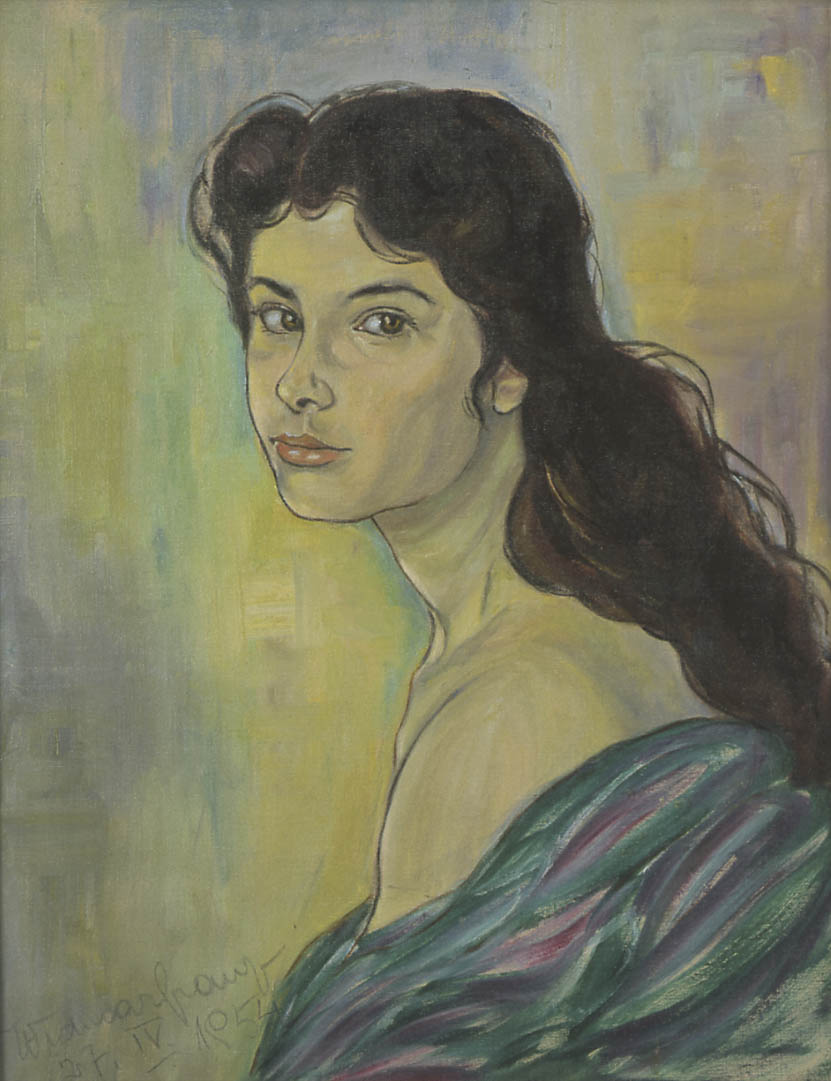
ohne Titel, 1954, Nr. 406, Öl auf Leinwand, 52.5 x 41.5 cm
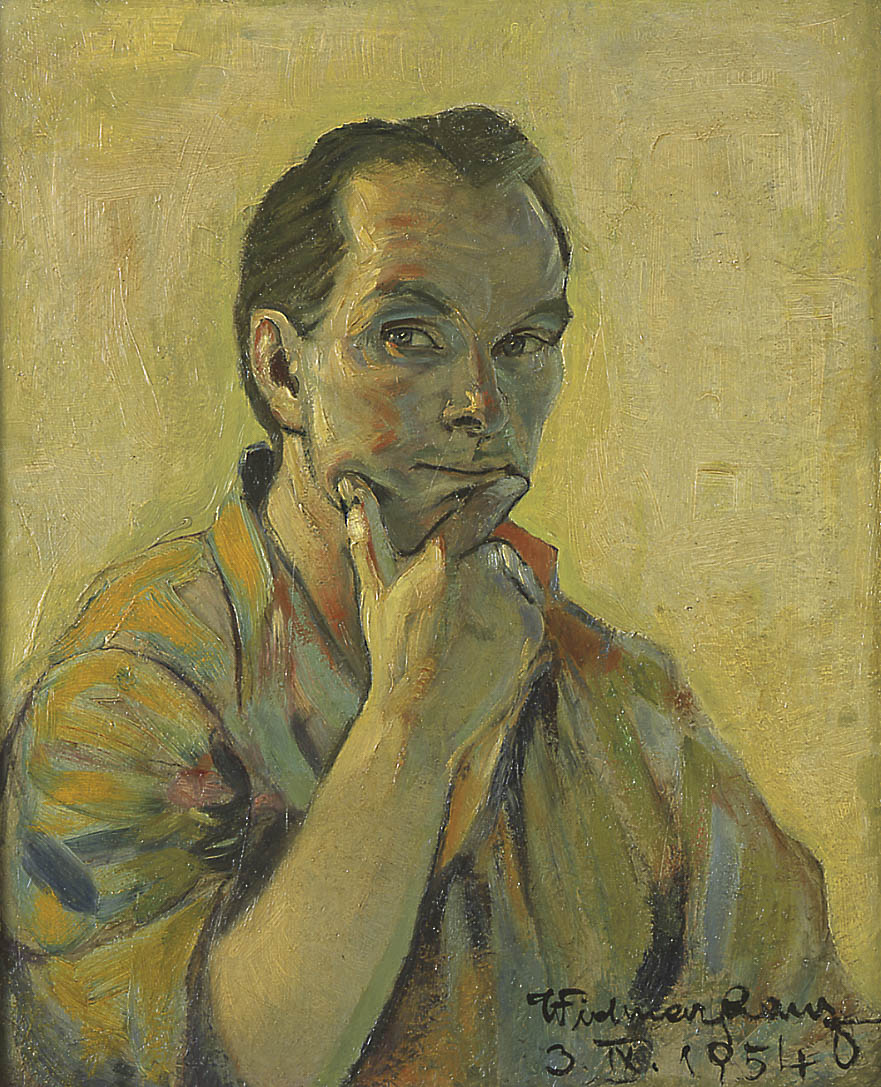
ohne Titel, Nr. 508, Öl auf Leinwand, 46 x 38 cm
Widmar‘s portraits recall the search for artistic representation by someone capable of not only capturing a likeness of the subject‘s appearance, but also the characteristics that define the person portrayed as an individual. He drew on a wide variety of compositional devices in his search for satisfactory solutions to express the entire being of the subject. The stylistic variations range from depictions with naturalistic virtuosity to almost abstract or expressive representations where the persons portrayed appear only in fragmented form in the composition. The remainder of Widmar‘s oeuvre suggests that the stylistically broad interpretation of the portrait should not simply be interpreted as an obvious consequence of the artist‘s profound interest in portrait painting. Nonetheless, the creative struggle to represent the external appearance of the subject, to capture the personality, and to select the right painting style is especially manifest in his depictions of individuals.
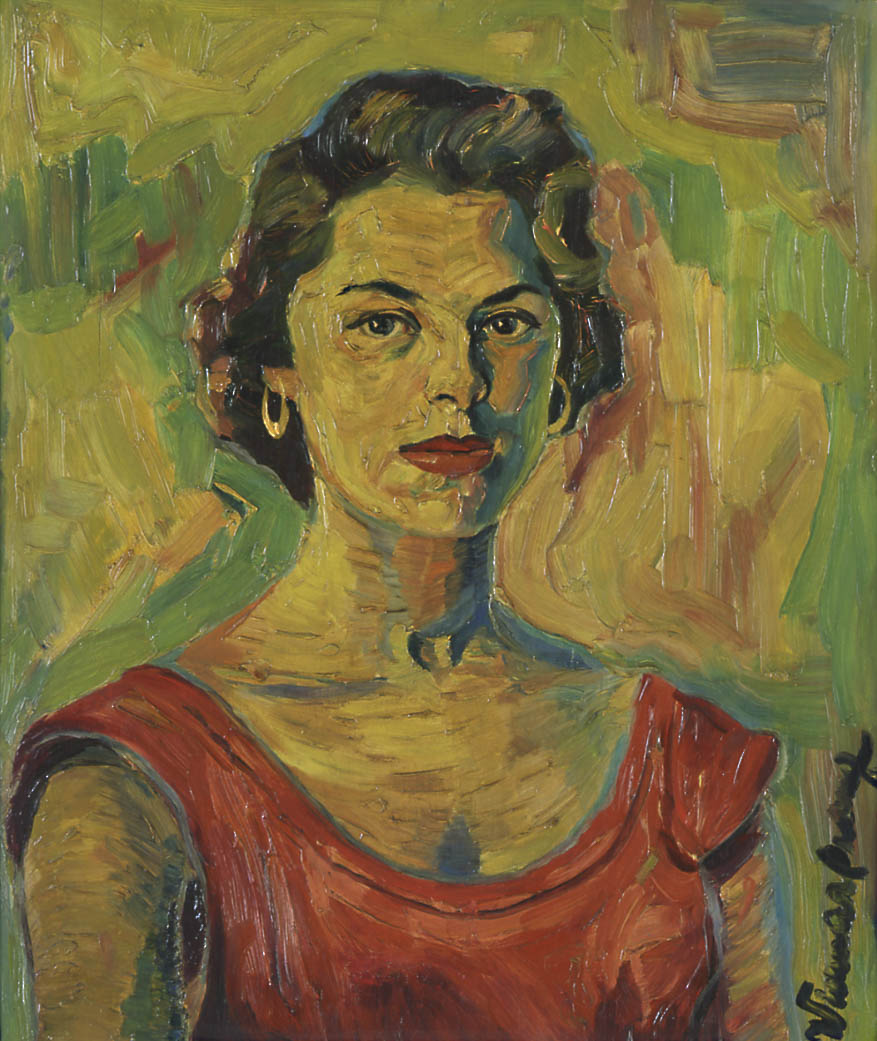
ohne Titel, Nr. 184, Öl auf Leinwand, 54 x 46 cm

ohne Titel, Nr. 410, Öl auf Leinwand, 74 x 54.5 cm
In this genre, the relevance of the stylistic peculiarity of the representation is especially apparent. The three portraits of Walter Wüthrich (cf. illustrations on p. 3 / no. 408, p. 24 / no. 410, and p. 25 / no. 357) attest to the artist‘s willingness to not limit the exploration of the character of a person he portrayed several times to a single manner of artistic expression. It appears that Widmar never established a systematic process for selecting a painting style as a decisive factor in his search for the expression of a person, and this gave him the freedom to study the character of his models through a variety of different artistic approaches. This is all the more interesting in that by the very definition of the assignment, an artist is not only accountable to himself in the case of a portrait painting, but also to the model. But even in these instances Widmar appears to have placed his artistic concerns above the requirements and expectations of the persons portrayed. In his works, the evolution of a painting became a process that was wholly restricted to the artist and his imagination, and this discredits the claim that Widmar‘s paintings are nothing more than commissioned works.
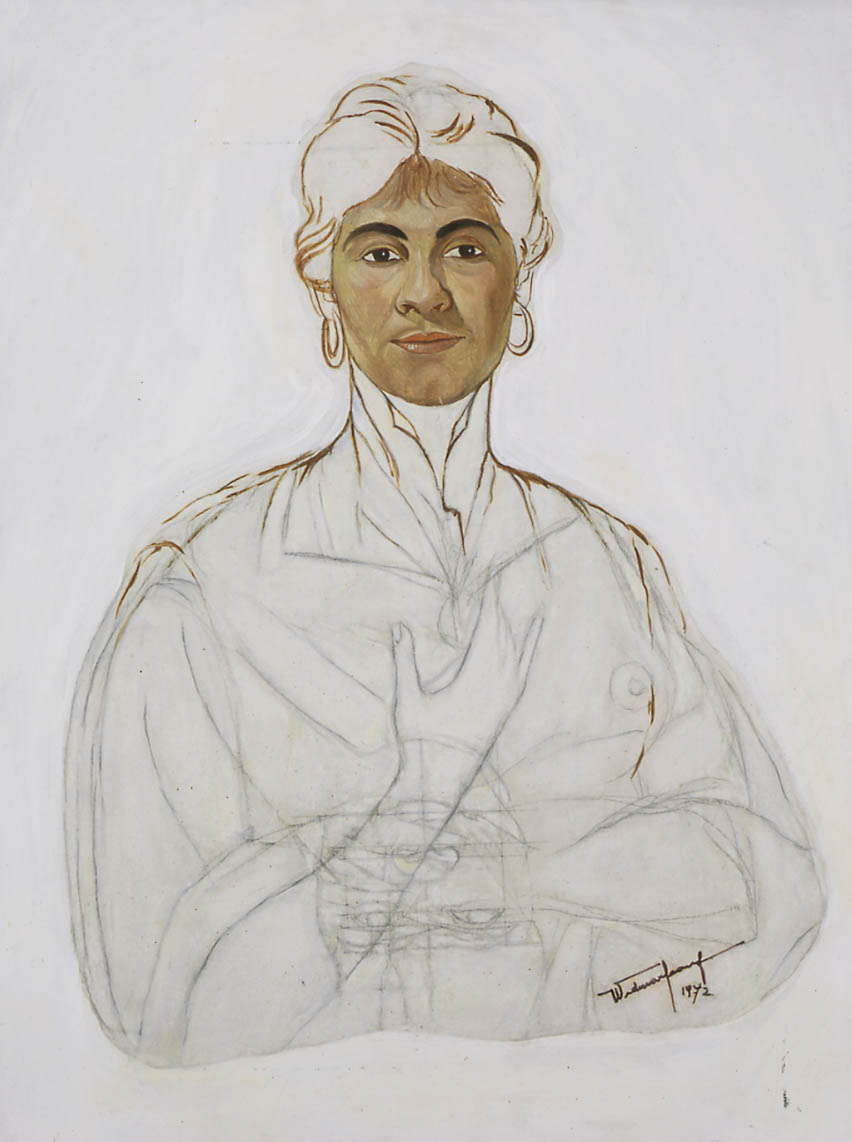
ohne Titel, 1972, Nr. 568, Öl auf Leinwand, 81 x 61 cm
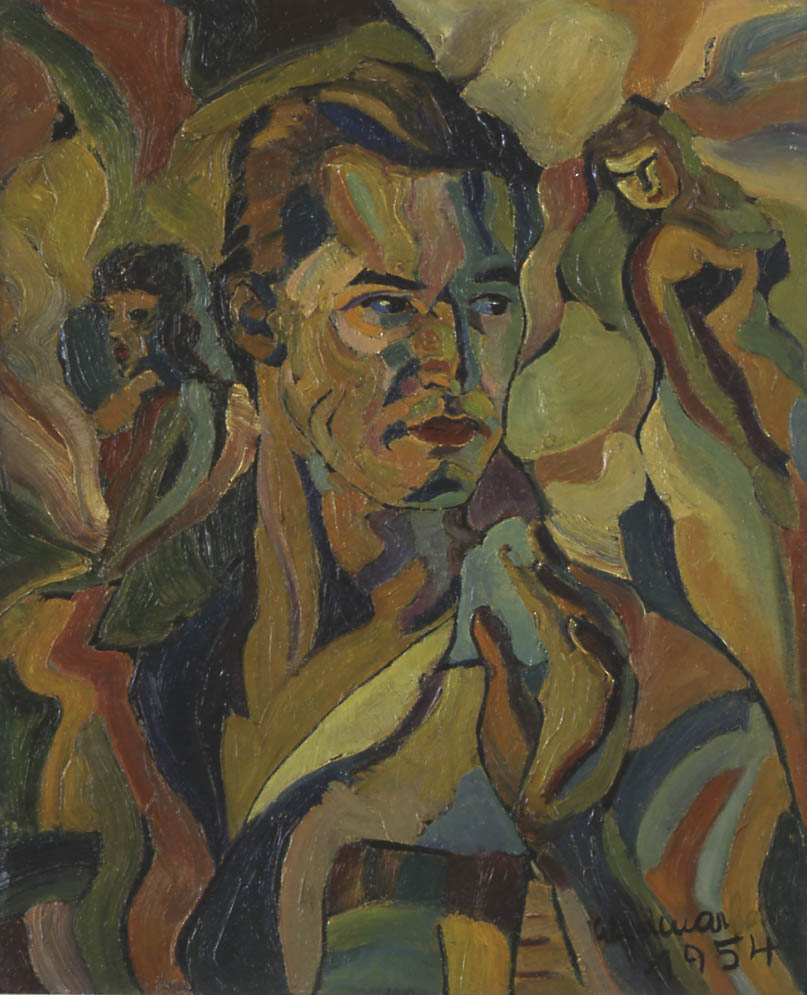
ohne Titel, 1972, Nr. 568, Öl auf Leinwand, 81 x 61 cm
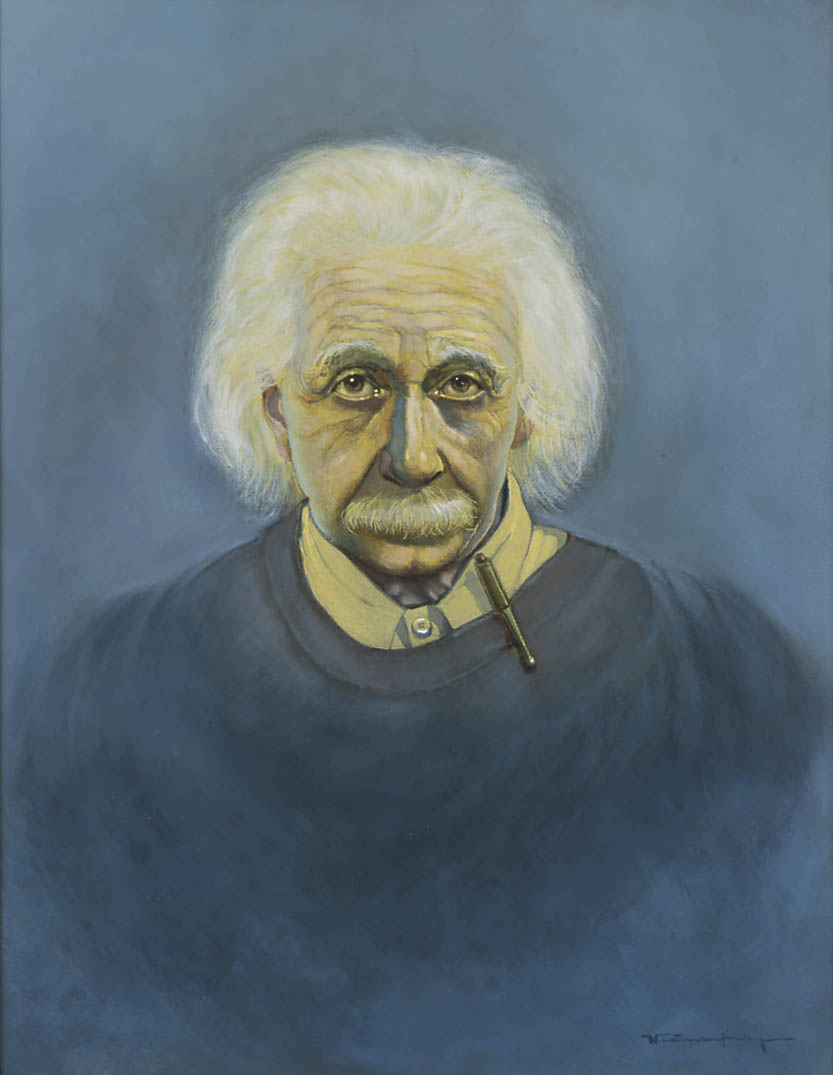
ohne Titel, 1972, Nr. 568, Öl auf Leinwand, 81 x 61 cm
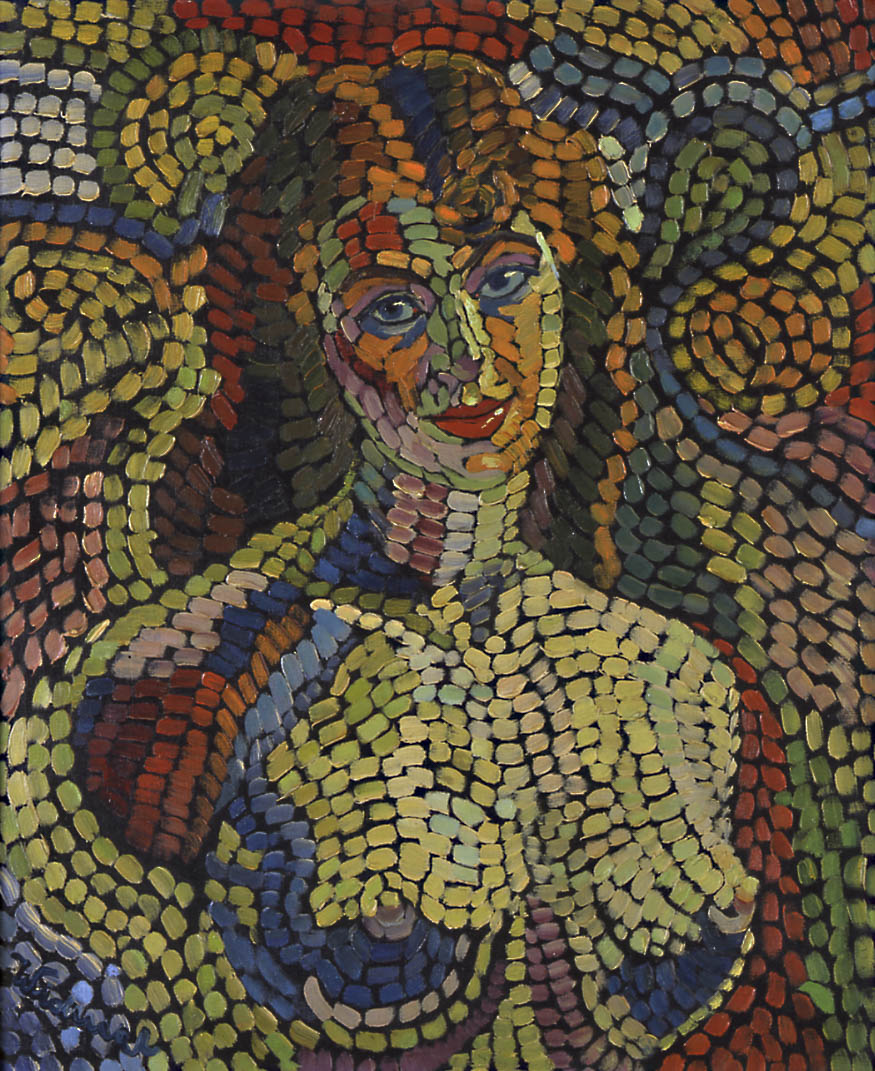
ohne Titel, Nr. 361, Öl auf Leinwand, 61 x 50 cm
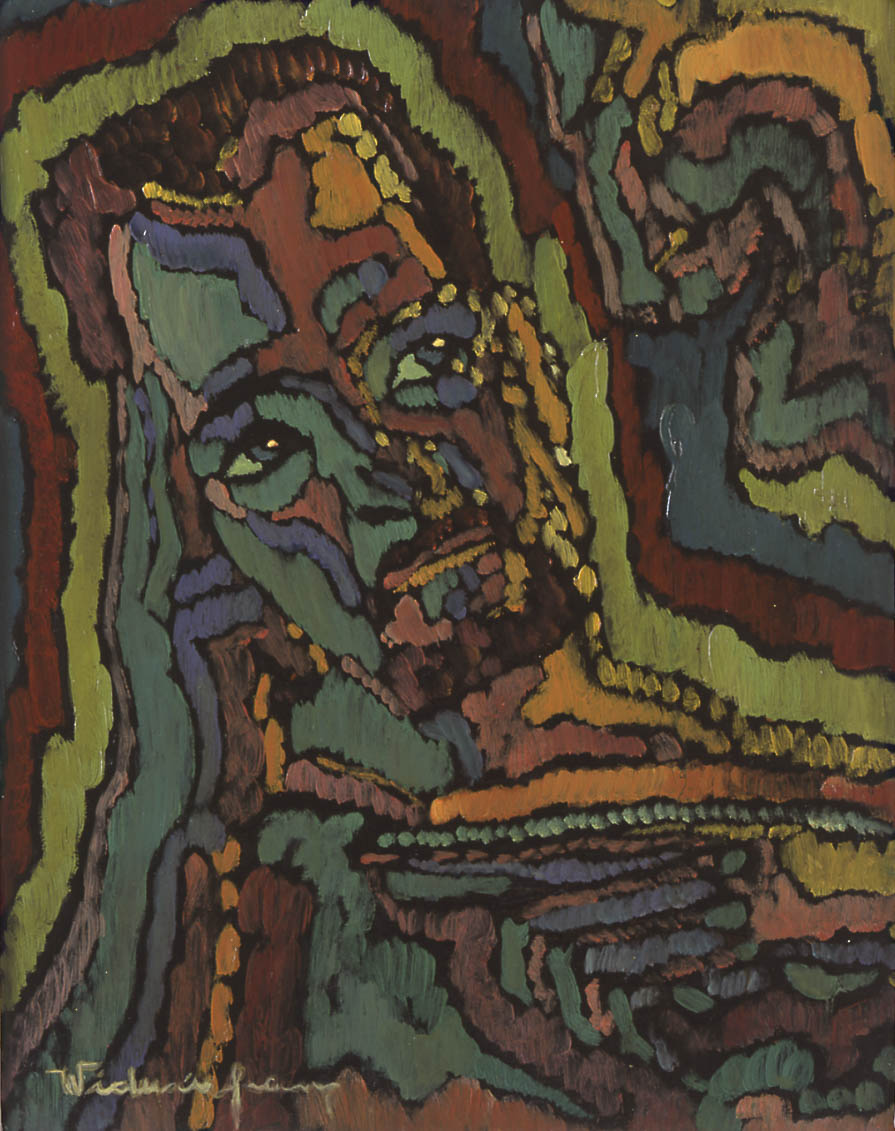
ohne Titel, Nr. 465, Öl auf Leinwand, 45 x 36 cm
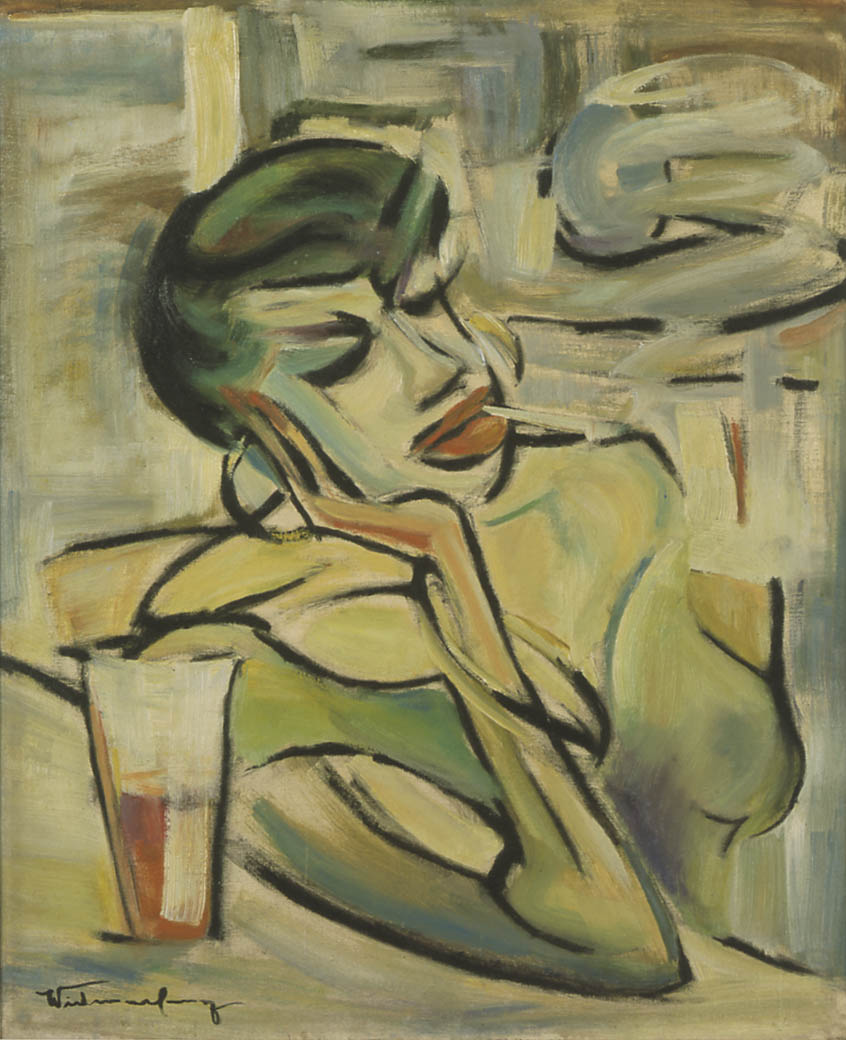
ohne Titel, Nr. 443, Öl auf Leinwand, 61 x 50 cm

ohne Titel, Nr. 472, Öl auf Leinwand, 62.5 x 54 cm
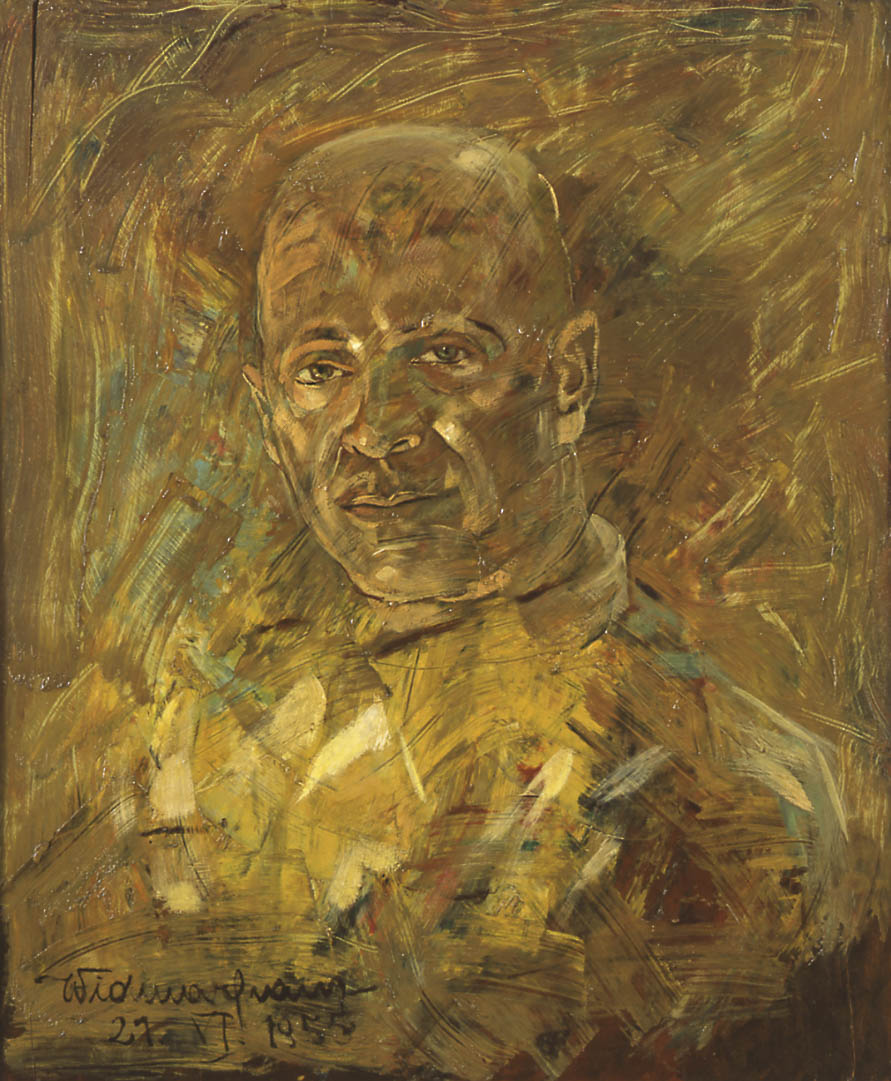
ohne Titel, 1955, Nr. 425, Öl auf Leinwand, 55 x 46 cm
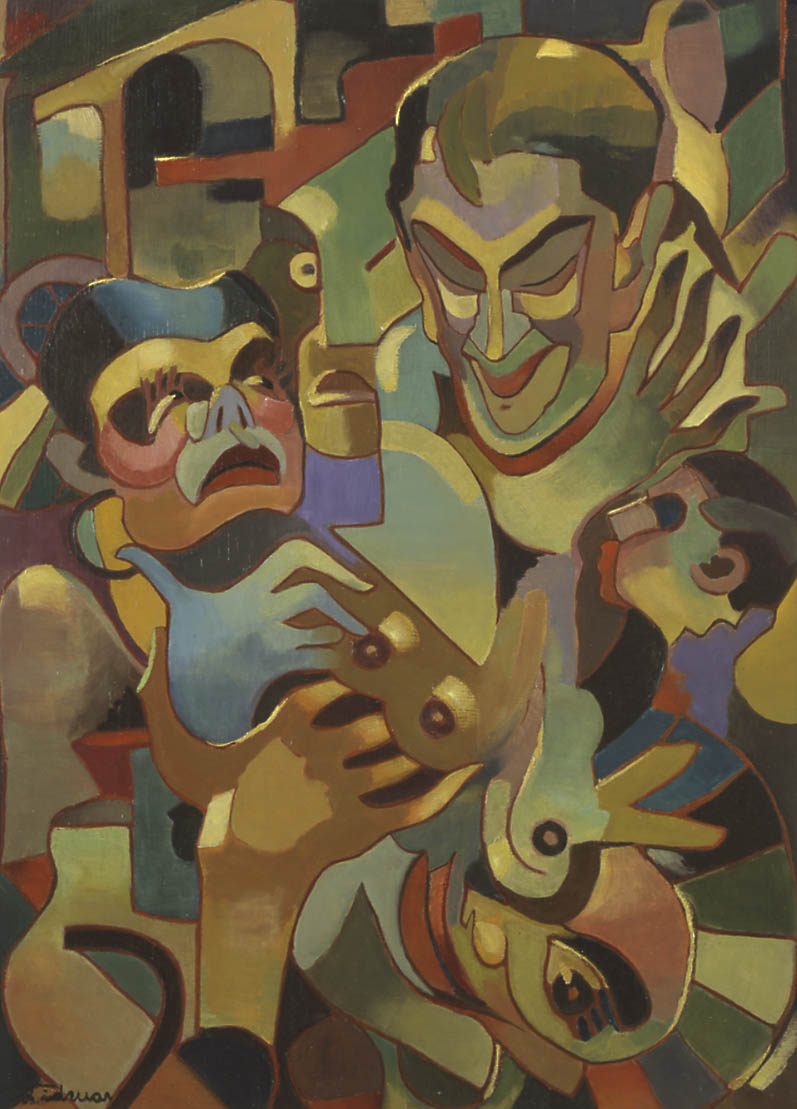
ohne Titel, Nr. 343, Öl auf Leinwand, 83 x 60 cm
LANDSCAPE PAINTINGS
As mentioned earlier, Widmar’s landscape paintings occupy a special position alongside portraiture in terms of quantity alone. Widmar’s urge to paint was almost obsessive. He rode his motorcycle around the Santa Tereza district, explored the landscapes of Petropolis and Friburgo on foot, and visited various towns in the State of Rio. He made sketches on his travels that later served as studies for his oil paintings, which he always painted in the studio. Throughout his life, Widmar had a special affinity for the landscape. In the remote areas around Rio he found the creative freedom that was so characteristic of his paintings. He always elevated his momentary sentiments and impressions above any dogma that comes from the adherence to a particular style. In a very direct way, Widmar’s landscapes reflect his various emotional states and his very unique perception of the world. Even so, his perspective is not always easy to fathom, and its pathos and sentimentalism can sometimes be overbearing.
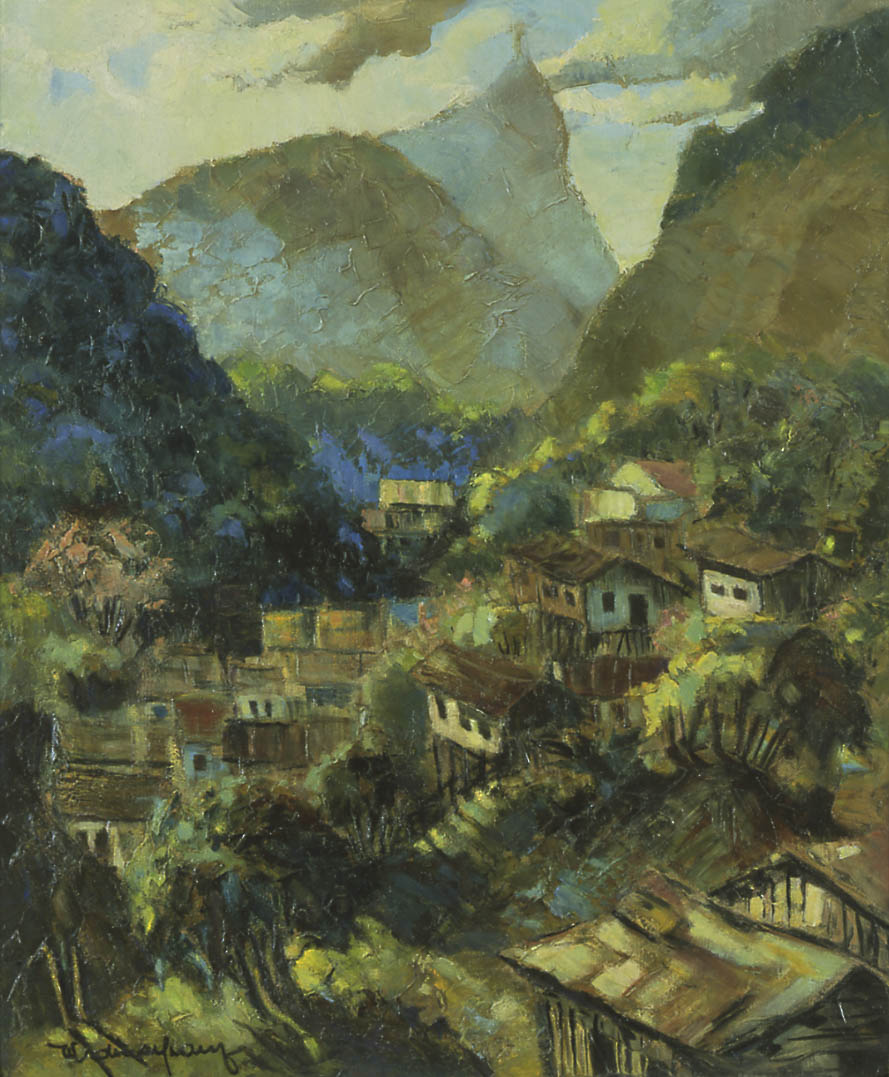
ohne Titel, Nr. 327, Öl auf Leinwand, 91 x 76 cm
But his original and individualistic interpretation of landscape painting is an especially distinctive characteristic of his art. Having immigrated from Europe, the artist found his own access to this prominent genre of painting, and perhaps precisely because of his origins developed a very personal means of interpretation that would have been denied to an artist from Brazil – if only on the basis of cultural background. In his landscape paintings, Widmar not only reveals his eye for reproducing the picturesque in nature, but also demonstrates his sensitivity as an inquisitive explorer seeking orientation in a new and exciting environment. He was compelled to capture in his paintings the elements that he felt were most characteristic of the landscape around him. The fact that he also incorporated atypical elements in his landscape paintings underscores his signature trait – creative originality – and sometimes conveys a sense that the landscapes were perceived through the eye of a foreigner.
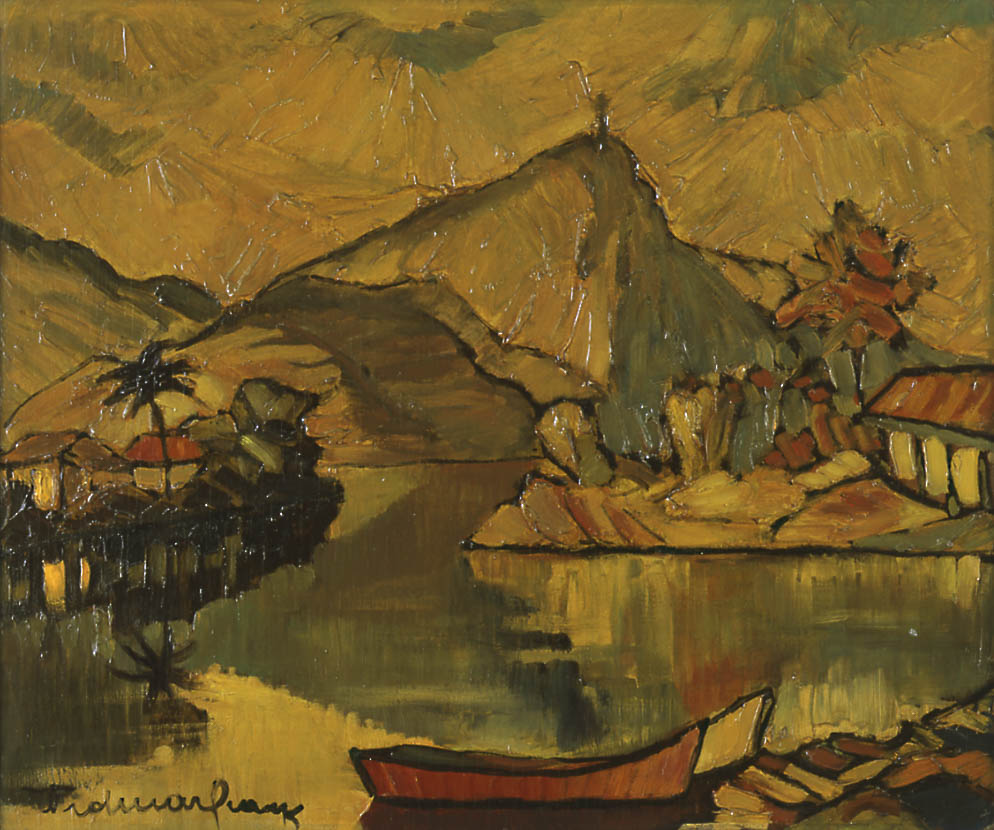
ohne Titel, Nr. 493, Öl auf Leinwand, 53 x 40 cm
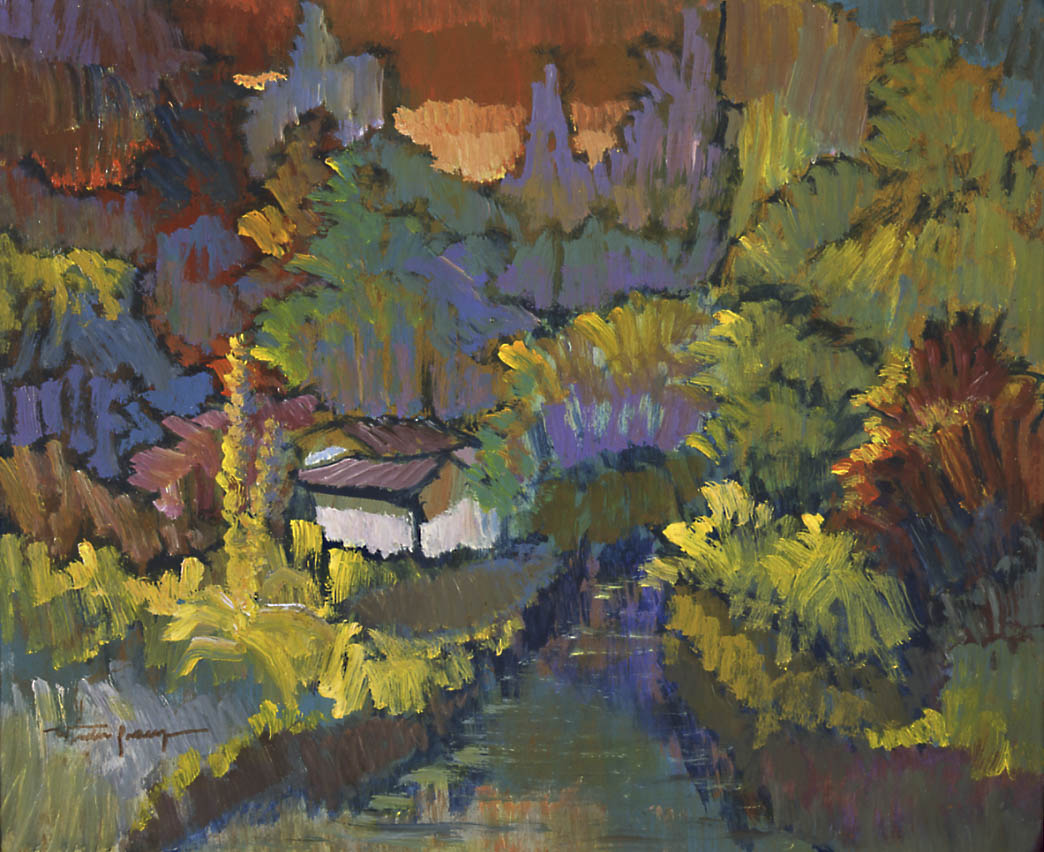
ohne Titel, Nr. 490, Öl auf Leinwand, 60 x 44.5 cm
This may be one of the reasons why Widmar’s landscape paintings also include several that are somewhat gloomy and melancholic. As an example, the composition with a path at sunset (cf. illustration on p. 50 / no. 511) attests to a sentimental side of the artist that even betrays a hint of homesickness. The painting becomes a projection surface for very personal desires and associations. The indeterminable quality of these projections is what in fact what inspires fascination in studying Widmar’s landscape paintings. It is precisely because we, the viewers, are given a great deal of room for our own thoughts that even the understanding of Widmar as a person becomes a projection surface that in the end is up to each of us to elaborate.
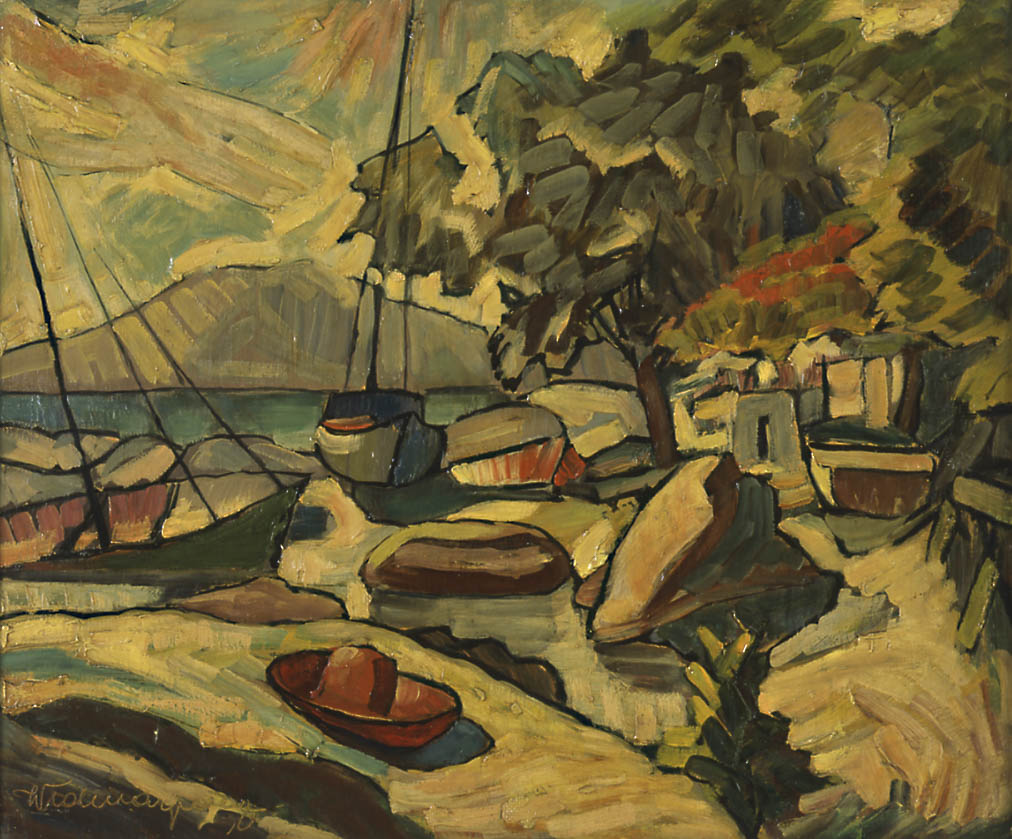
ohne Titel, Nr. 432, Öl auf Leinwand, 55 x 46 cm

ohne Titel, Nr. 433, Öl auf Leinwand, 50 x 45.5 cm
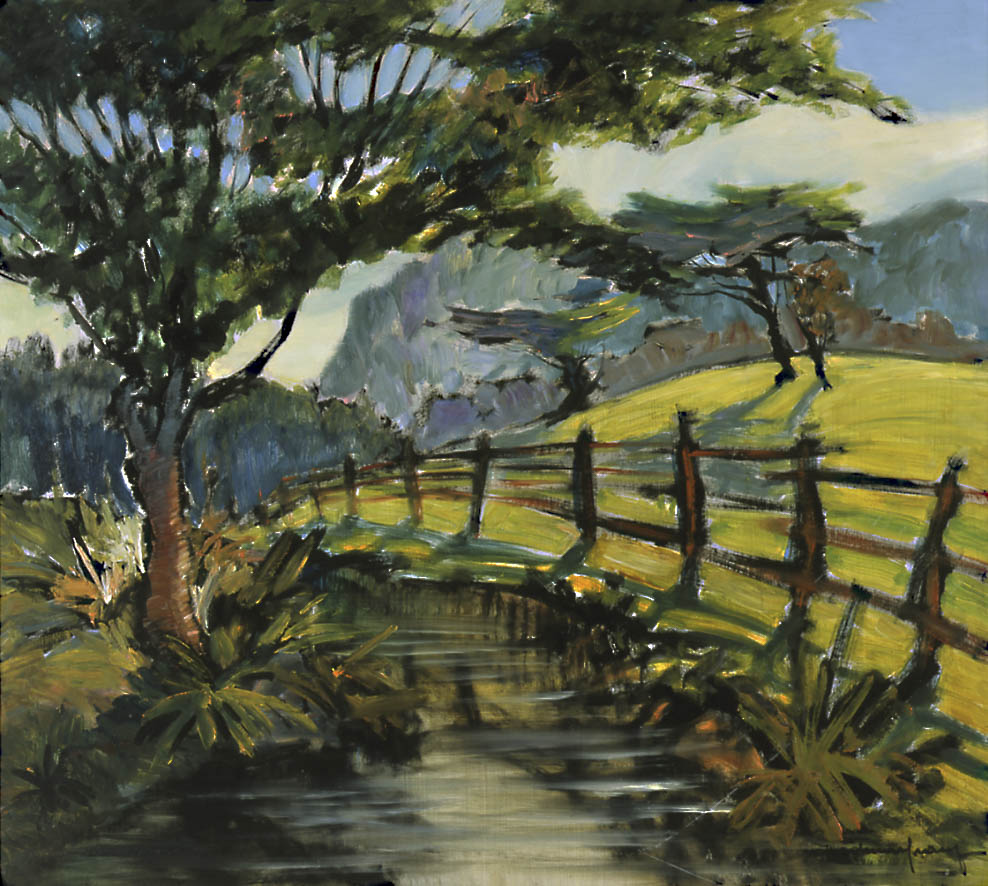
ohne Titel, Nr. 276, Öl auf Leinwand, 100 x 90 cm
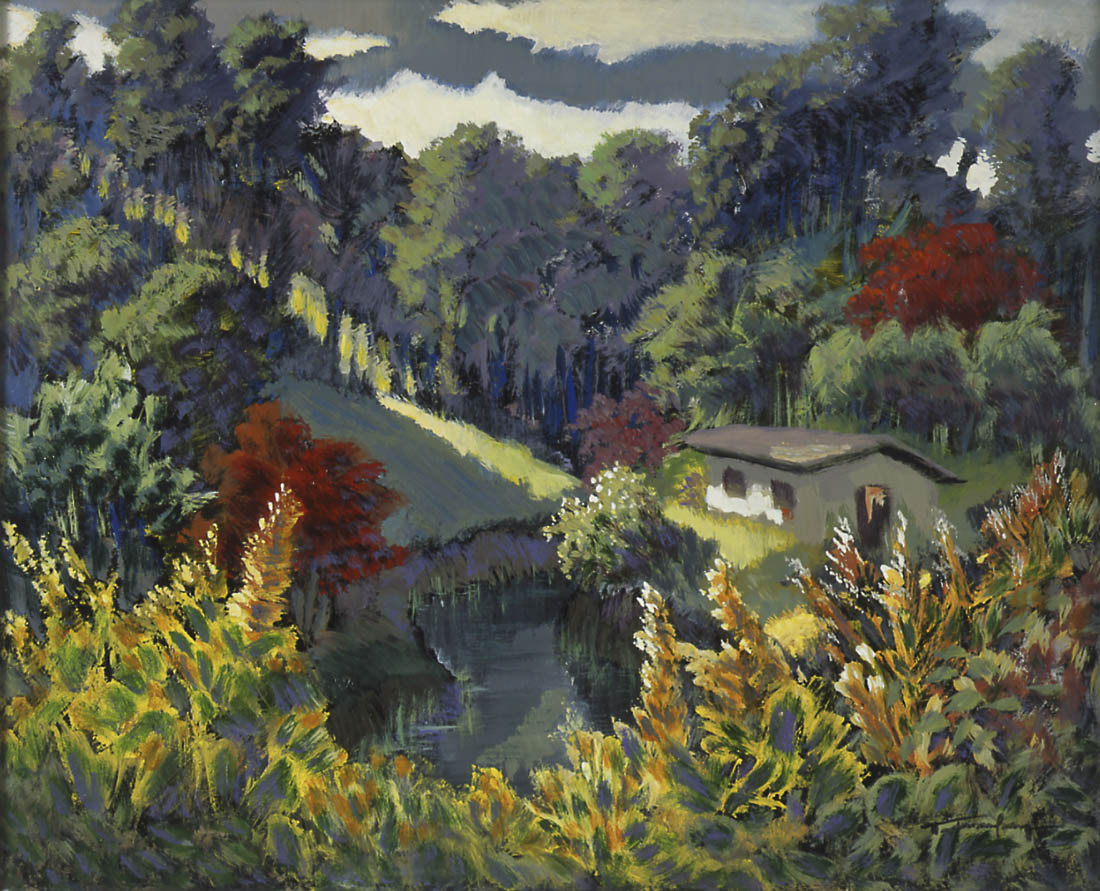
ohne Titel, Nr. 292, Öl auf Leinwand, 75 x 61 cm
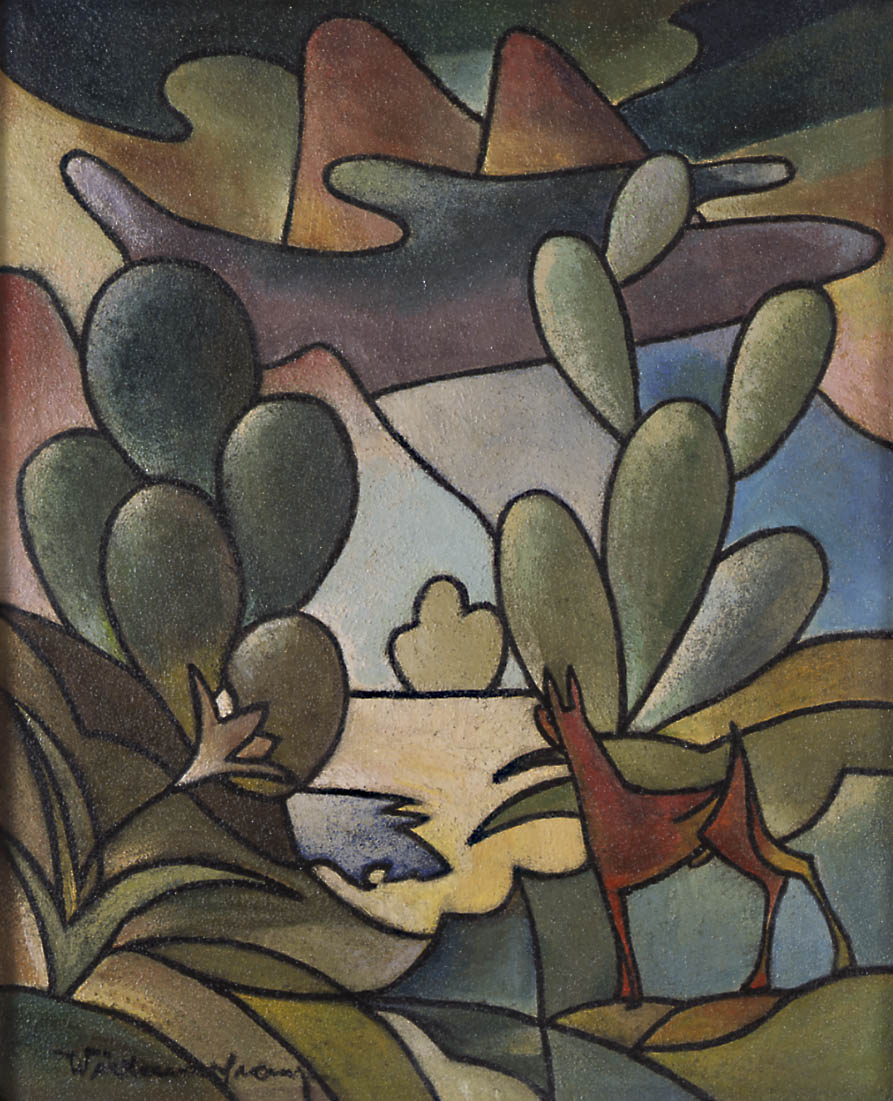
ohne Titel, Nr. 382, Öl auf Leinwand, 83 x 68 cm

ohne Titel, Nr. 239, Öl auf Leinwand, 75 x 61 cm
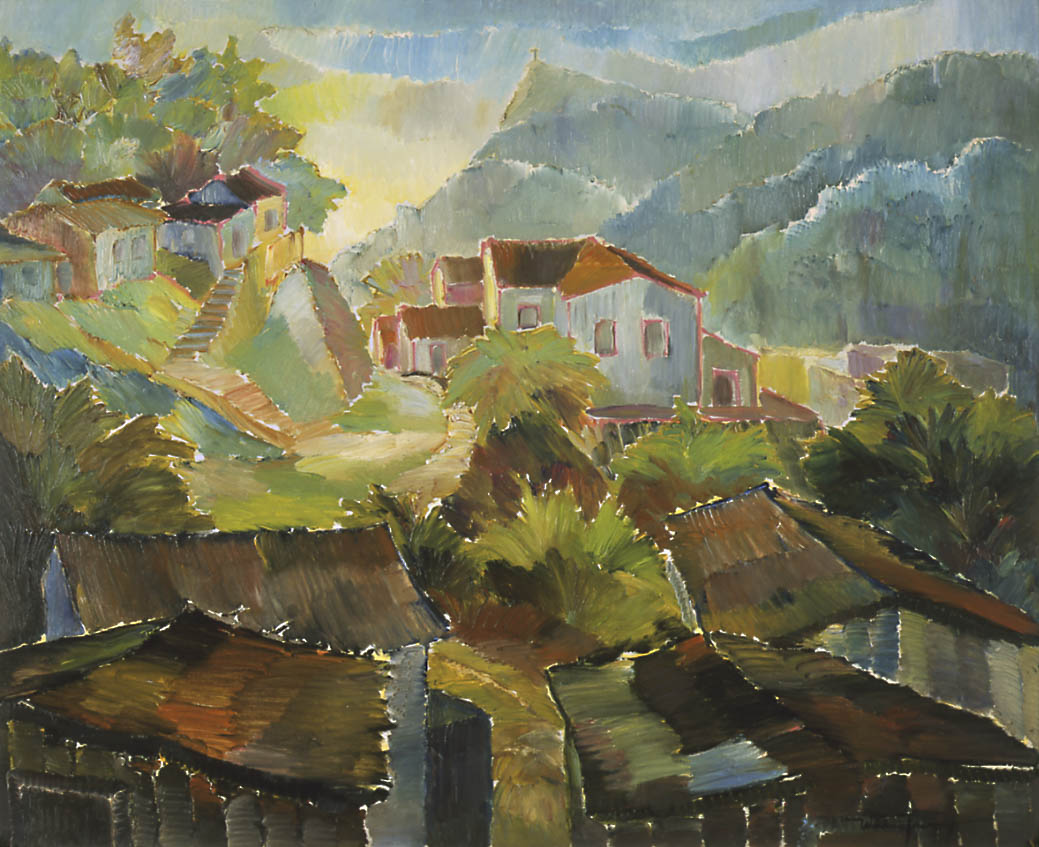
ohne Titel, Nr. 270, Öl auf Leinwand, 100 x 81 cm

ohne Titel, Nr. 236, Öl auf Leinwand, 122 x 85 cm
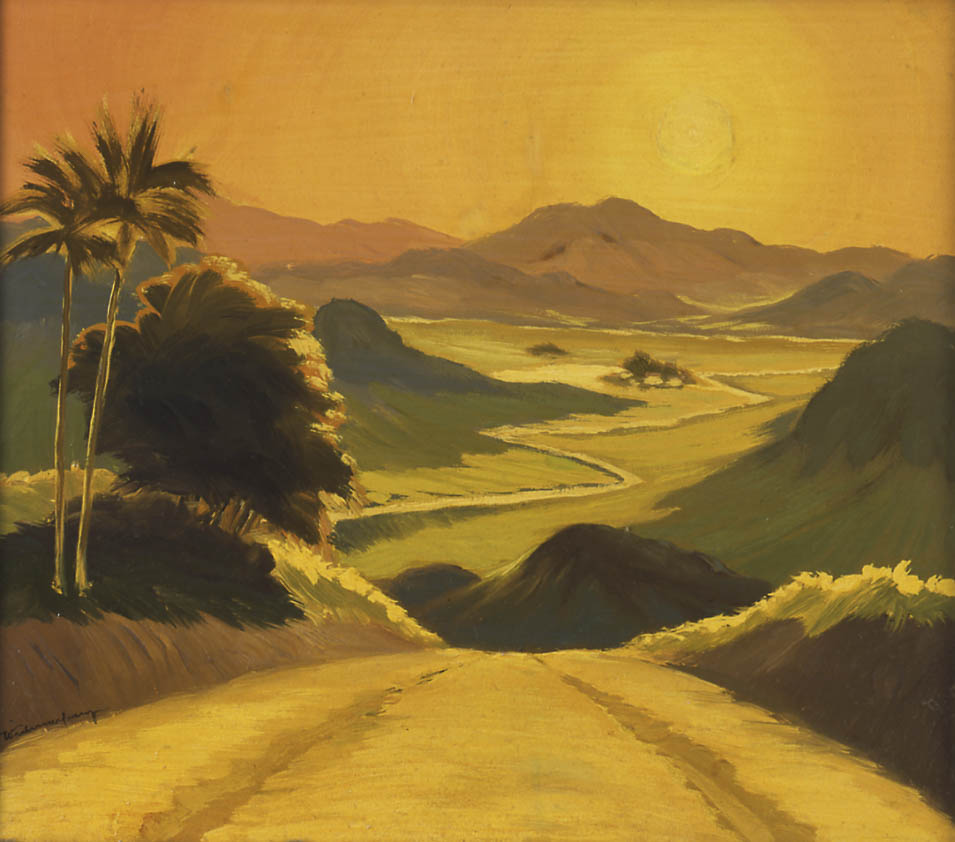
ohne Titel, Nr. 511, Öl auf Leinwand, 47 x 41.5 cm
STILL LIFES
If we classify the subjects in the paintings of Franz Josef Widmar according to larger, autonomous groups, his still lifes constitute one such group; categorizing these works as an independent genre within his oeuvre appears justified due to the artist‘s extensive treatment of the still life subject. In this connection, the application of paint using spray technique and the use of diluted paint deserve special mention – a rather unconventional approach in this genre in particular. This painting style occasionally occurs in other paintings by Widmar, but in his still lifes it can be considered a defining element from a formal perspective. The similarity of the haphazard splashes of colour with the natural appearance of flowers could explain why he chose this motif so frequently as the subject of his still lifes. It should be noted that this body of work is not dominated by classic flower still lifes with interior scenes, but rather consists primarily of works that could easily be interpreted as nature studies. This interpretation seems appropriate since Widmar only rarely introduced a table with a vase on it as a classic basic element in flower still lifes.
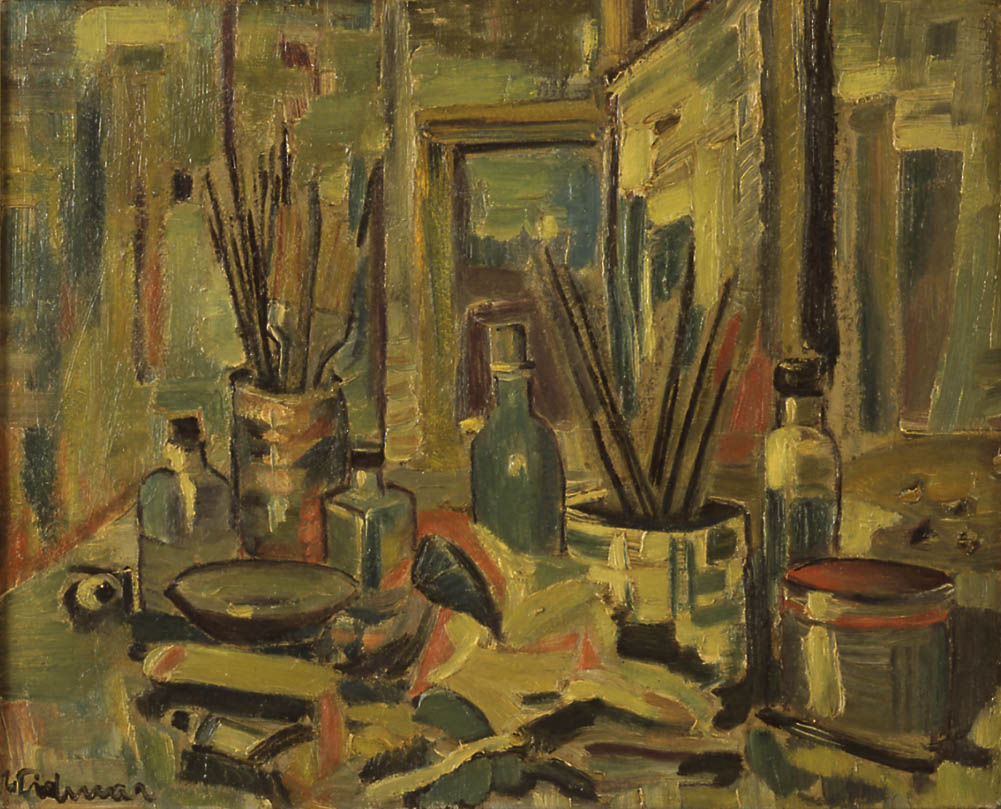
ohne Titel, Nr. 492, Öl auf Leinwand, 61 x 50 cm
Widmar‘s studio still life (cf. illustration on p. 53 / no. 492) demonstrates that he clearly had the ability to follow traditional compositional forms. This work bears witness to his deep understanding for the arrangement of the objects depicted (painting utensils in a studio), and it also confirms his mastery of light and colour. The view through the open door in the background introduces additional tension to the nearly spherical appearance of the room‘s interior. The painting gives the privileged viewer an intimate look at the studio as the artist‘s laboratory. Widmar ascribes a nearly sacred character to the room – a gesture that ultimately refers to the artist‘s self-stylization. The utensils depicted seem to have always been there, as partners in a silent dialogue with the artist. The absence of the artist‘s physical presence is an attempt to exemplify the existence and appearance of the objects themselves in their bare reality through the medium of painting, and even more saliently establishes their position in the studio as a place of artistic creativity. On the assumption that Widmar was probably depicting his immediate work environment – possibly his studio in Posto Quatro on the Copacabana – and the tools he used for his daily work, and if the painted utensils are interpreted as a reflection of the artist‘s thought processes and craft, this work can be considered one of the most personal paintings among Franz Widmar‘s entire oeuvre.
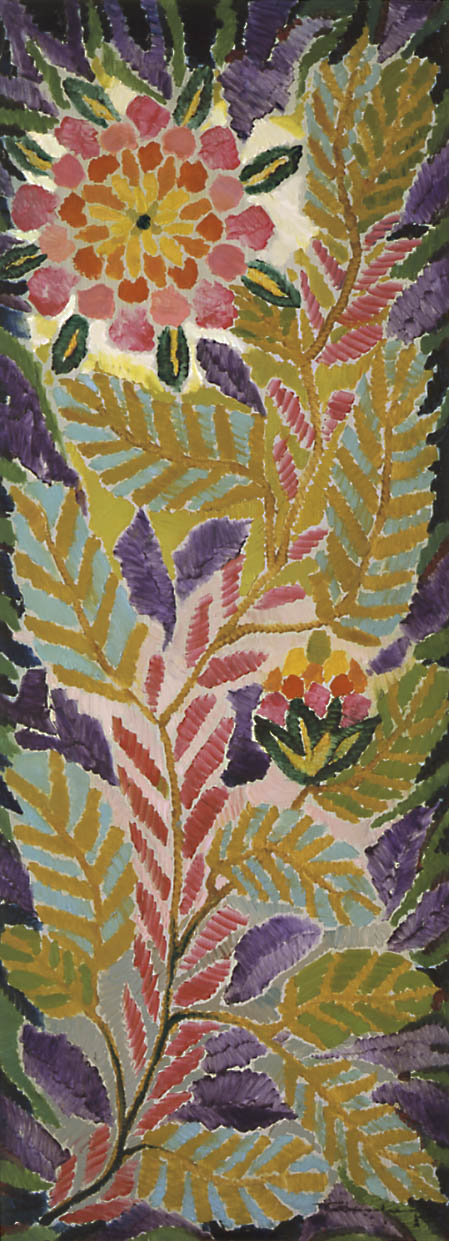
ohne Titel, Nr. 091, Öl auf Leinwand, 160 x 60 cm

ohne Titel, Nr. 090, Öl auf Leinwand, 160 x 60 cm
His obsession with painting and his urge to explore his direct environment through the painted picture are vividly manifest in the densely arranged composition. The painting utensils become very personal tools in the service of the artist‘s perception of reality. The compositional intensity reflects Widmar‘s strong connection to these tools, and they are eulogized for posterity in this still life.
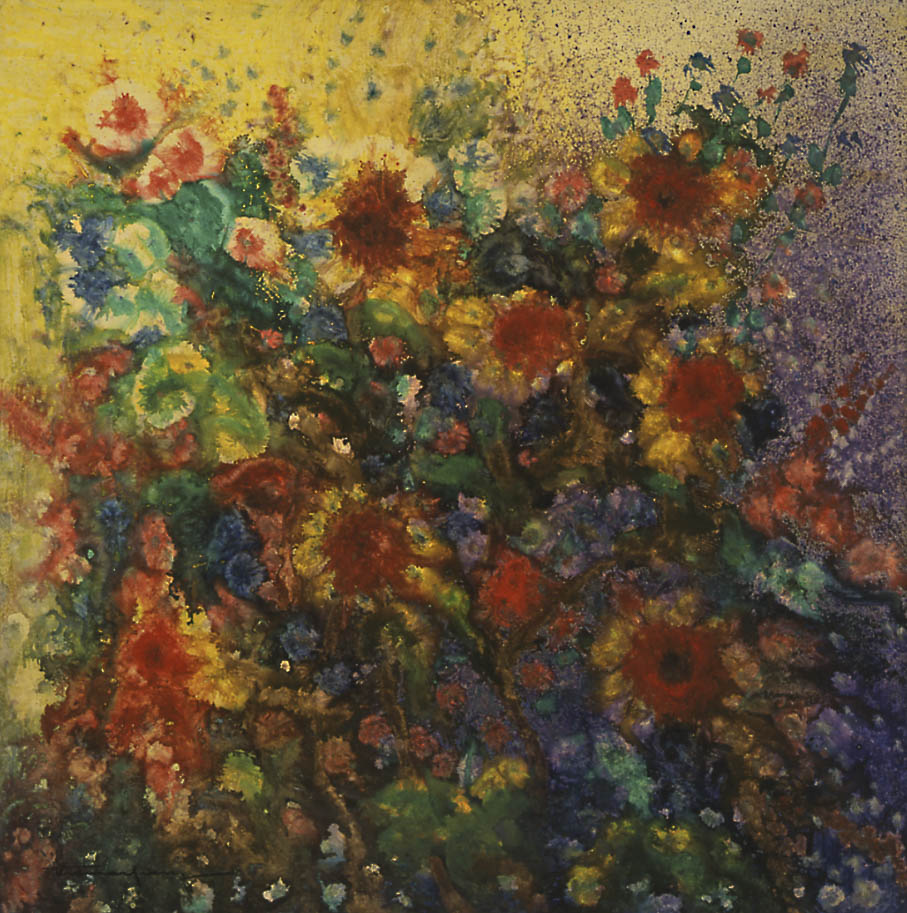
ohne Titel, Nr. 366, Öl auf Leinwand, 70.5 x 70 cm
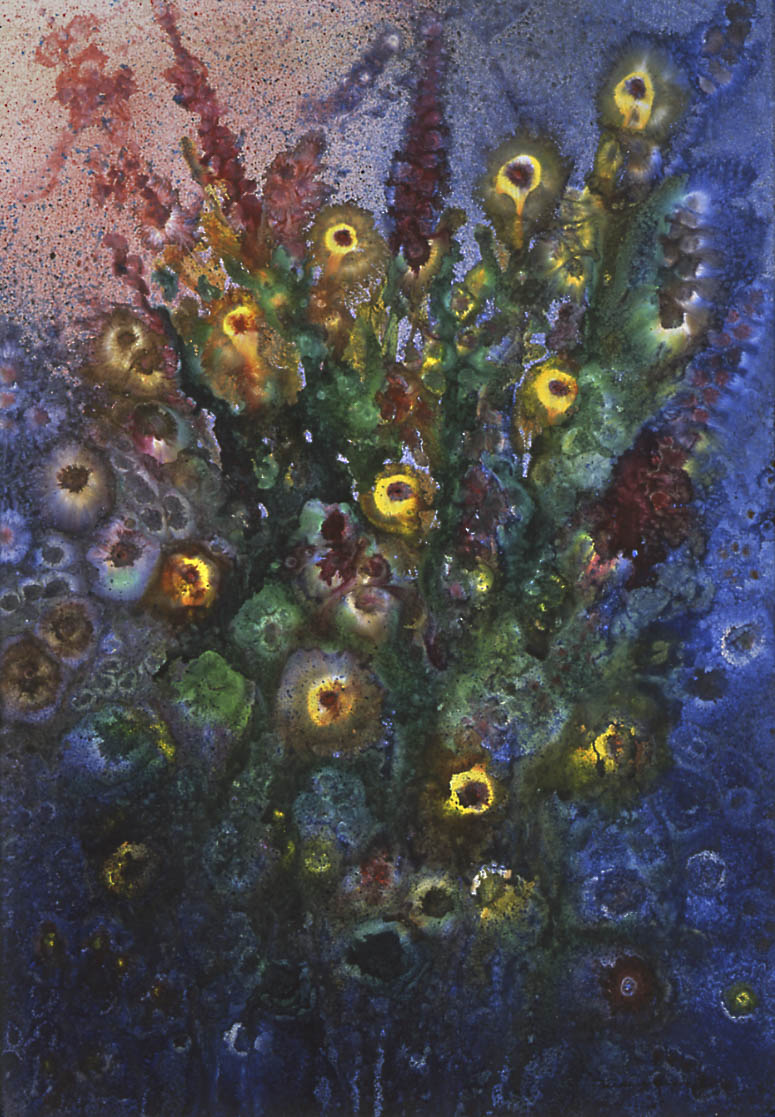
ohne Titel, Nr. 106, Öl auf Leinwand, 100 x 70 cm
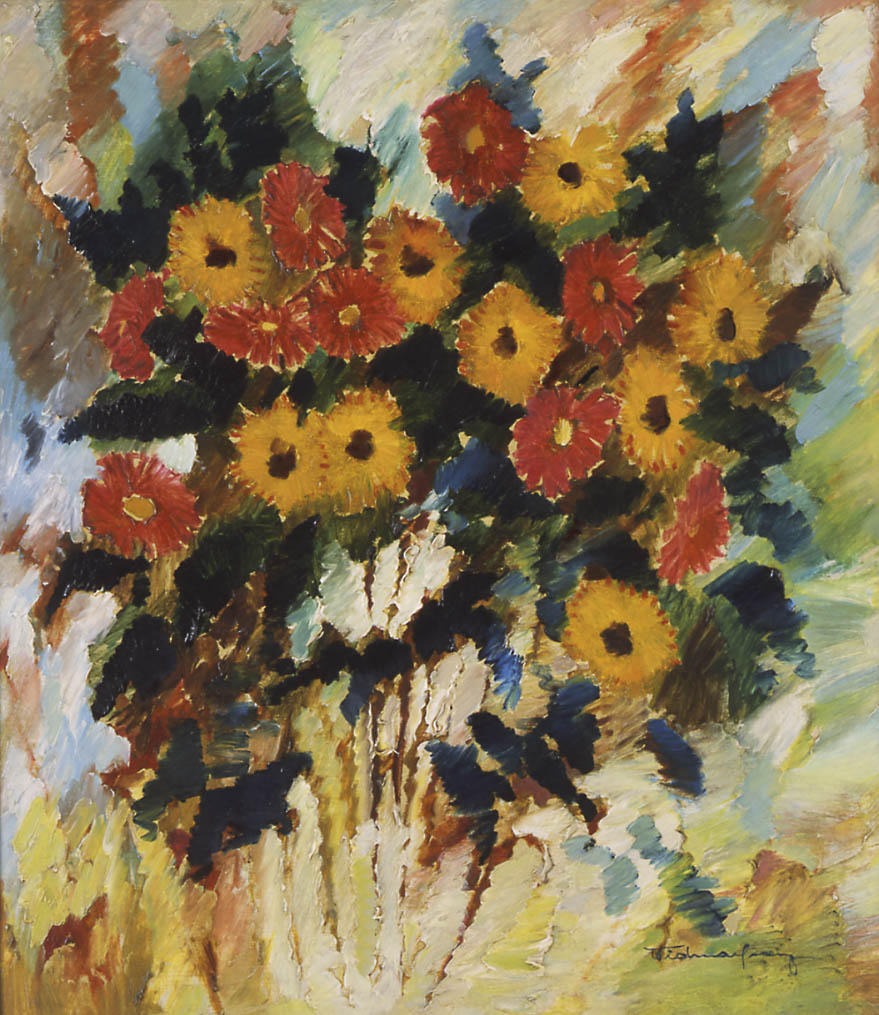
ohne Titel, Nr. 360, Öl auf Leinwand, 85 x 74 cm
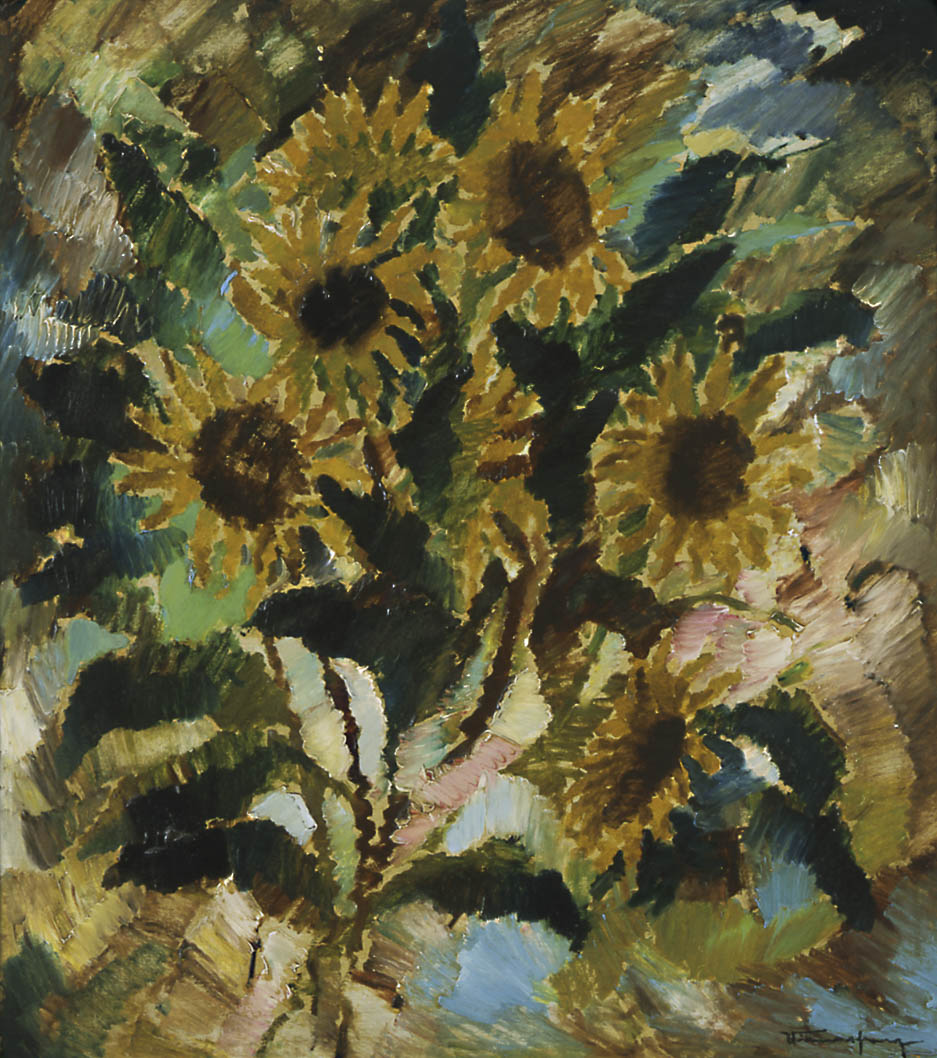
ohne Titel, Nr. 358, Öl auf Leinwand, 84 x 74 cm
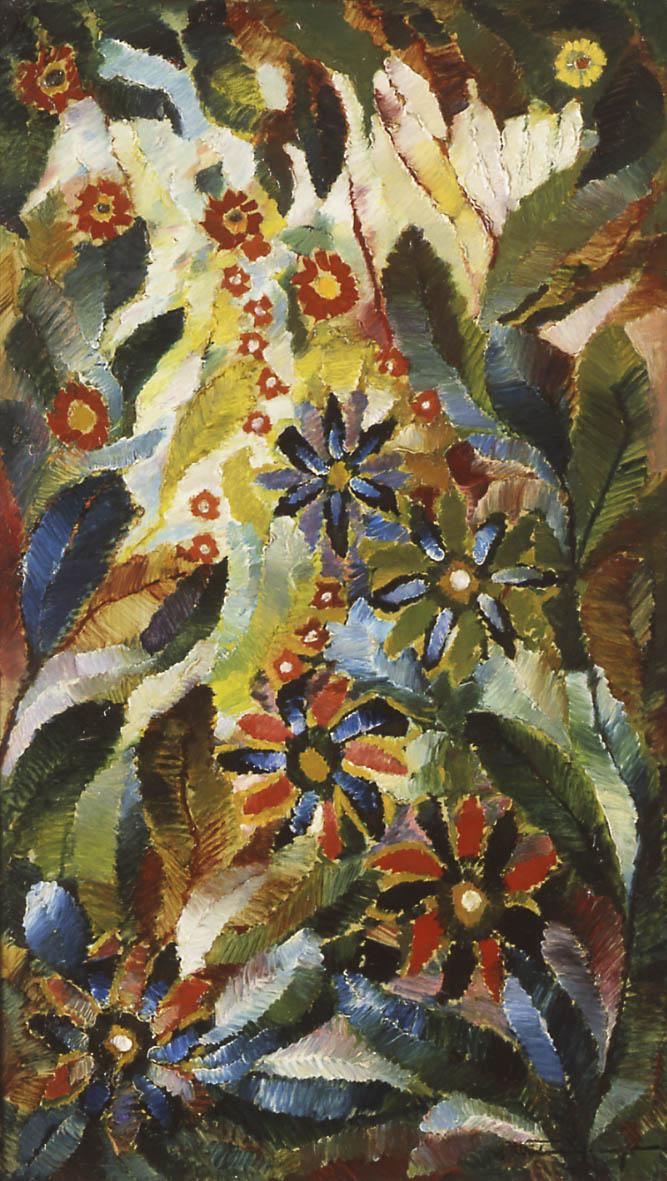
ohne Titel, Nr. 309, Öl auf Leinwand, 100 x 57.5 cm

ohne Titel, Nr. 122, Öl auf Leinwand, 89.5 x 61 cm

ohne Titel, Nr. 359, Öl auf Leinwand, 84 x 74 cm

ohne Titel, Nr. 236, Öl auf Leinwand, 122 x 85 cm

ohne Titel, Nr. 511, Öl auf Leinwand, 47 x 41.5 cm
GEOMETRIC & ABSTRACT PAINTING
The lack of continuity in these paintings in terms of subject matter and pictorial composition makes it harder to classify them as a distinct body of works. It is therefore not possible to identify a common theme in Widmar‘s geometric abstractions. The clear division of certain paintings into formally defined groups is not conclusive and also needs to be viewed in the perspective of the remainder of Franz Josef Widmar‘s oeuvre.
In one painting, a dancing, kissing couple can be identified (cf. illustration on p. 74 / no. 376), and another depicts a bird‘s eye view of a large city (cf. illustration on p. 75 / no. 288). These are two examples of how the artist abstracted objects that exist in material reality. In both cases, Widmar demonstrates a pronounced sense for the effect of colour and for the composition itself. The balanced colour scheme transforms the dancing couple into a single figure reflecting an emotional and physical feeling of connectedness and belonging. The figure can no longer be viewed as two separate entities side by side, but acquires its actual meaning through the physical synthesis transferred to the painting: the man and the woman are defined by their connection to each other here.
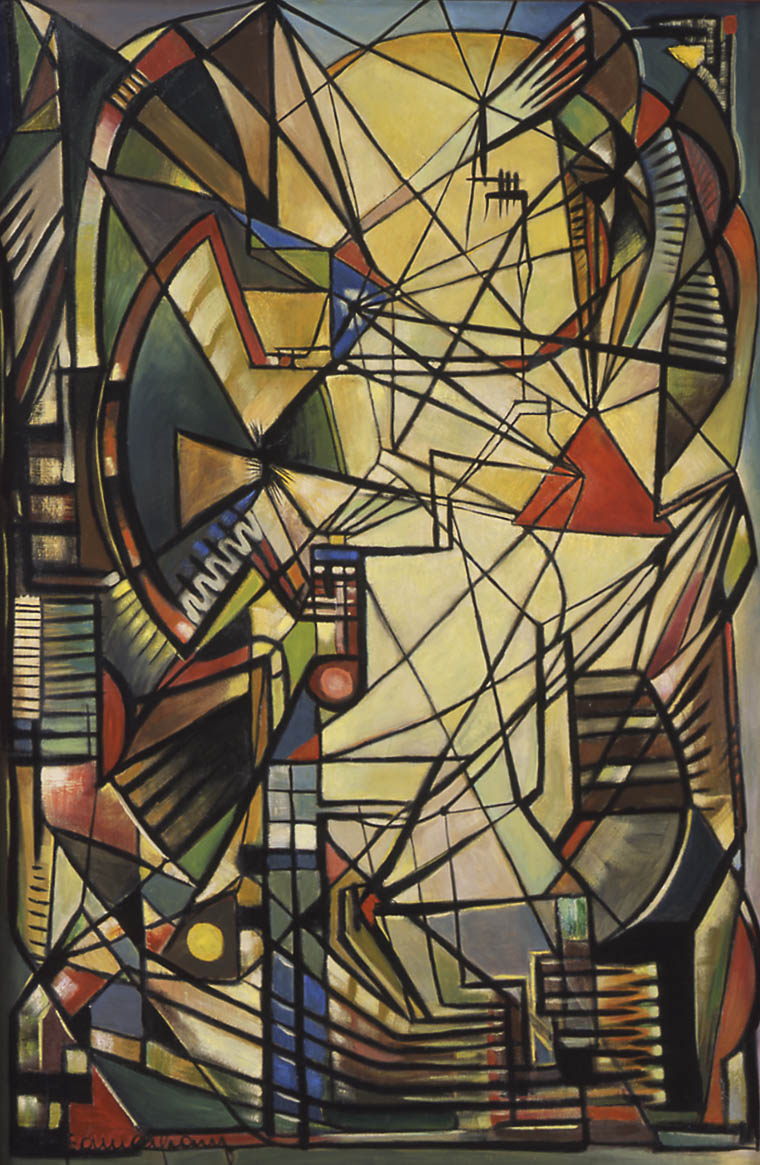
ohne Titel, Nr. 313, Öl auf Leinwand, 122 x 80.5 cm
This body of work also includes paintings that attempt to materialize more intellectual concepts. This non-representational approach to painting is especially evident in the paintings reproduced on pages 72 and 73 (no. 003 and no. 002, respectively). In both cases, geometric surfaces are arranged in a spiral shape and create the impression of dynamic depth. Widmar rejected even the slightest reference to representational form here. Primary colours are placed according to their tonal values on the same level as the pure and mixed fields of black and white. In these paintings, the artist moved in the direction of ‚concrete art‘, which more or less makes direct reference to geometric constructions and dispenses with symbolic meaning altogether. Based on the prominent theoretical approaches of Piet Mondrian and Theo van Doesburg, geometric abstract painting can be defined as a style that subjects its content entirely to the concerns and requirements of mathematics and balanced composition and thus establishes a dialectic antipode to mimetic modes of representation.
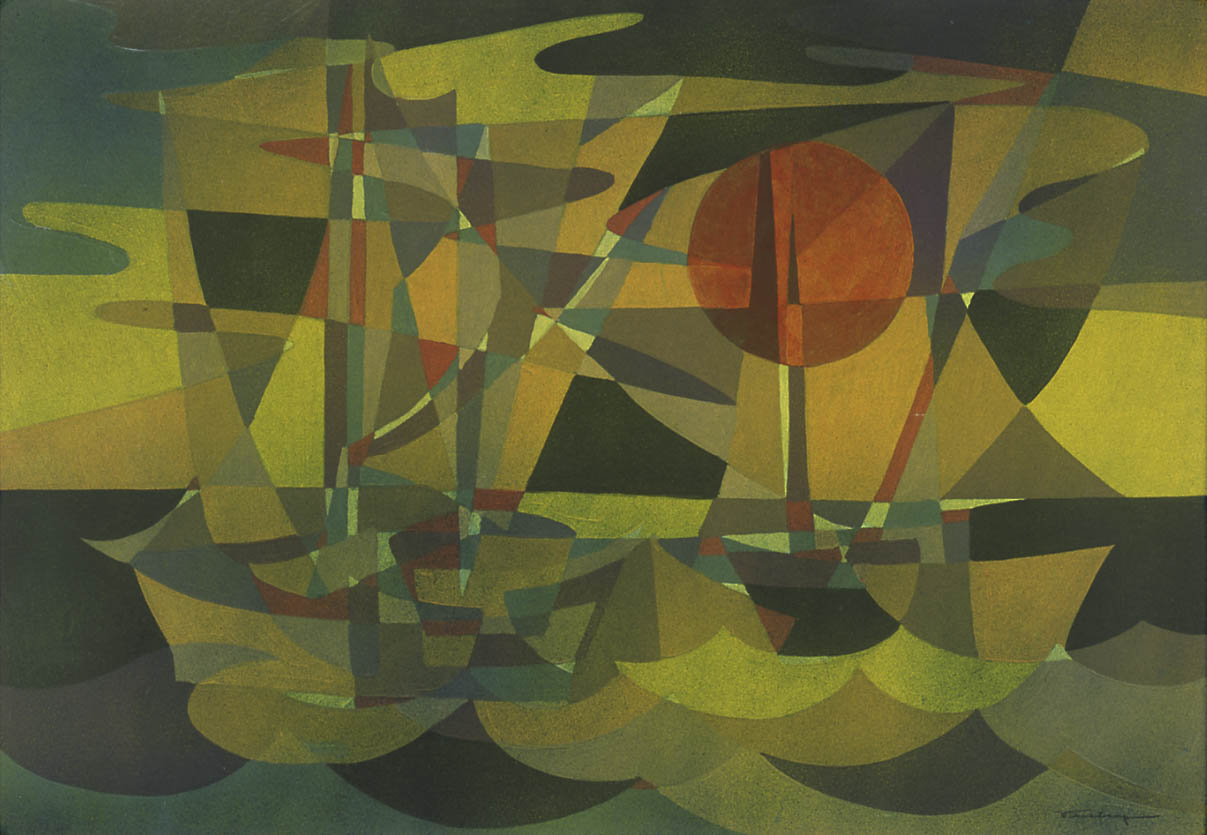
ohne Titel, Nr. 245, Öl auf Leinwand, 122 x 85 cm
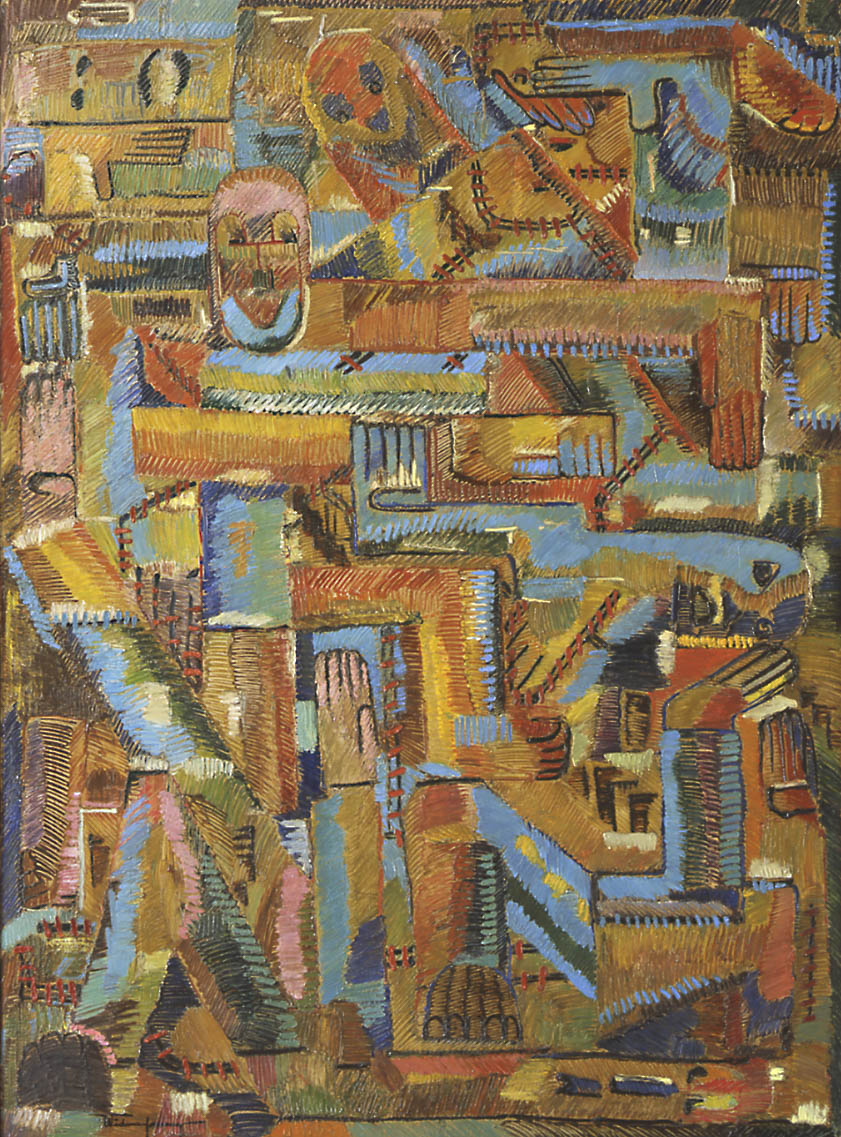
ohne Titel, Nr. 324, Öl auf Leinwand, 148 x 109.5 cm
The two paintings also shed light on another facet of Widmar‘s multilayered creativity: there is no longer any room here for a style characterized by gestural strokes and improvised spontaneity. The point is to transfer mental constructs to clearly defined, independent fields of colour, which in turn require a painstaking and technically sophisticated painting style. Rather than producing a one-dimensional movement into the picture, the spiral-shaped whorls establish an equally pronounced movement outward to the viewer. This creates an interplay between various directions of movement that do not have a clear orientation. Just as the spiral movement describes a path towards the centre, the same vector returns a movement from the centre outwards. This zone of indifferentiability goes hand in hand with the compositional balance of the colours. It exemplifies Widmar‘s artistic interest in transcending the representational through the search for a formal style.
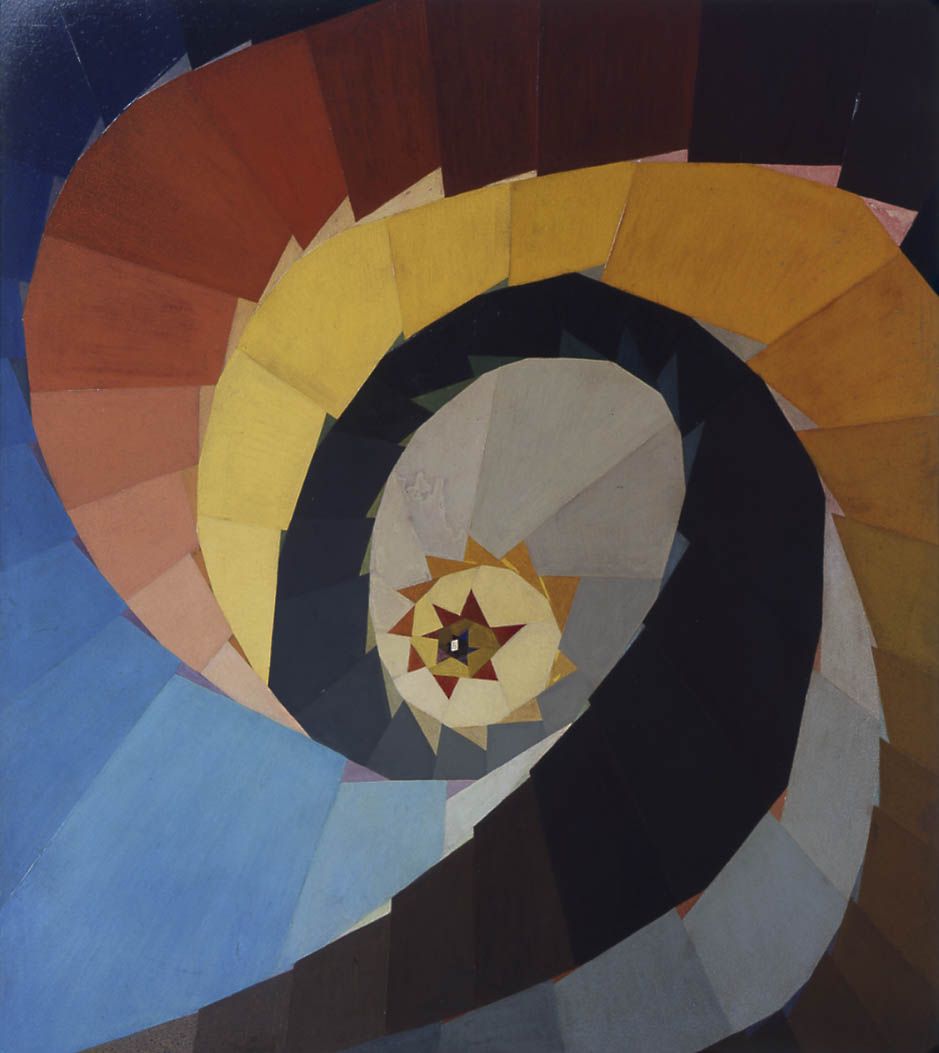
ohne Titel, Nr. 003, Öl auf Leinwand, 138 x 121 cm
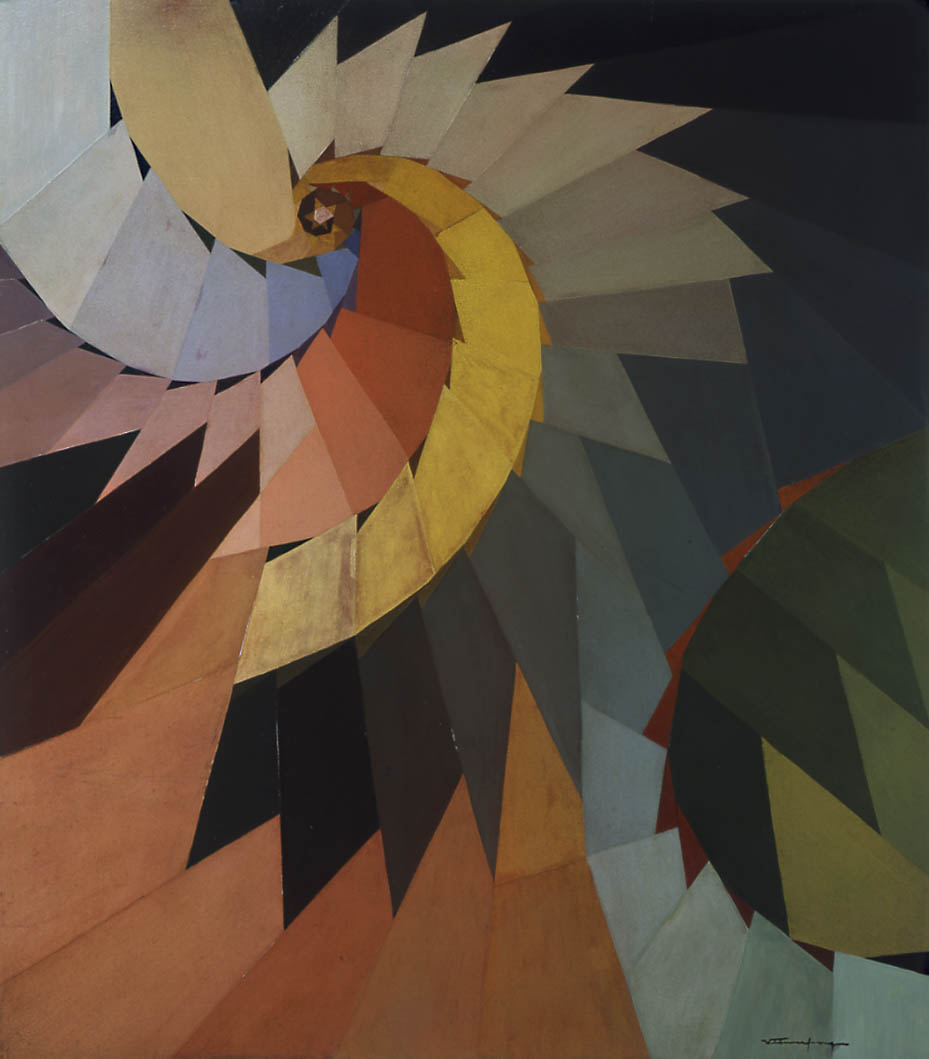
ohne Titel, Nr. 002, Öl auf Leinwand, 138 x 124 cm
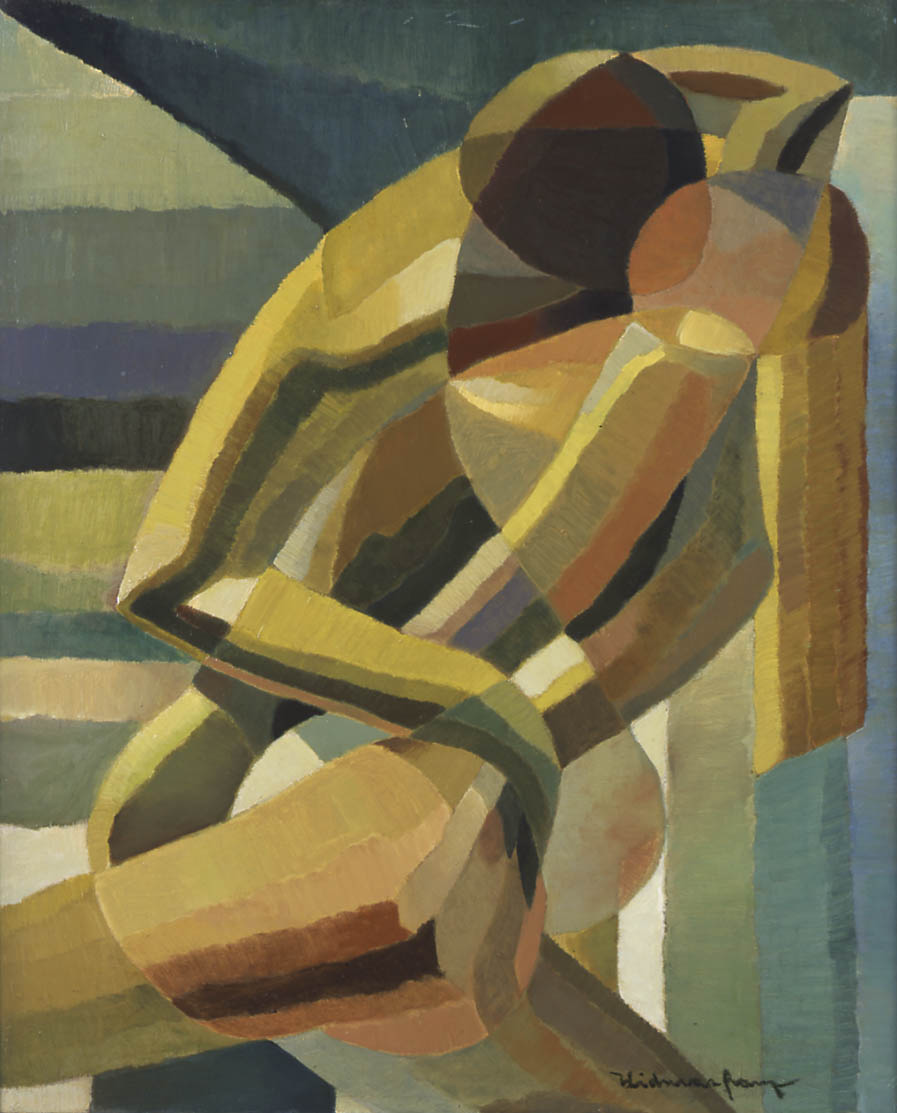
ohne Titel, Nr. 376, Öl auf Leinwand, 61.5 x 50.5 cm

ohne Titel, Nr. 288, Öl auf Leinwand, 122 x 94 cm
RELIGIOUS ART
Religious art represents the smallest group of works in Widmar’s oeuvre. We neither know whether the artist lived his life according to a certain religion nor what motivated Widmar to treat religious subjects in his painting. The only thing we can say with certainty is that Widmar was confronted with a religious environment in Brazil, if not earlier, and that its rituals and customs must have represented an entirely new experience for him. Since there is no indication that the religious paintings were commissioned works, we can assume that they were inspired by a deep personal relationship between the artist and the Christian religion.
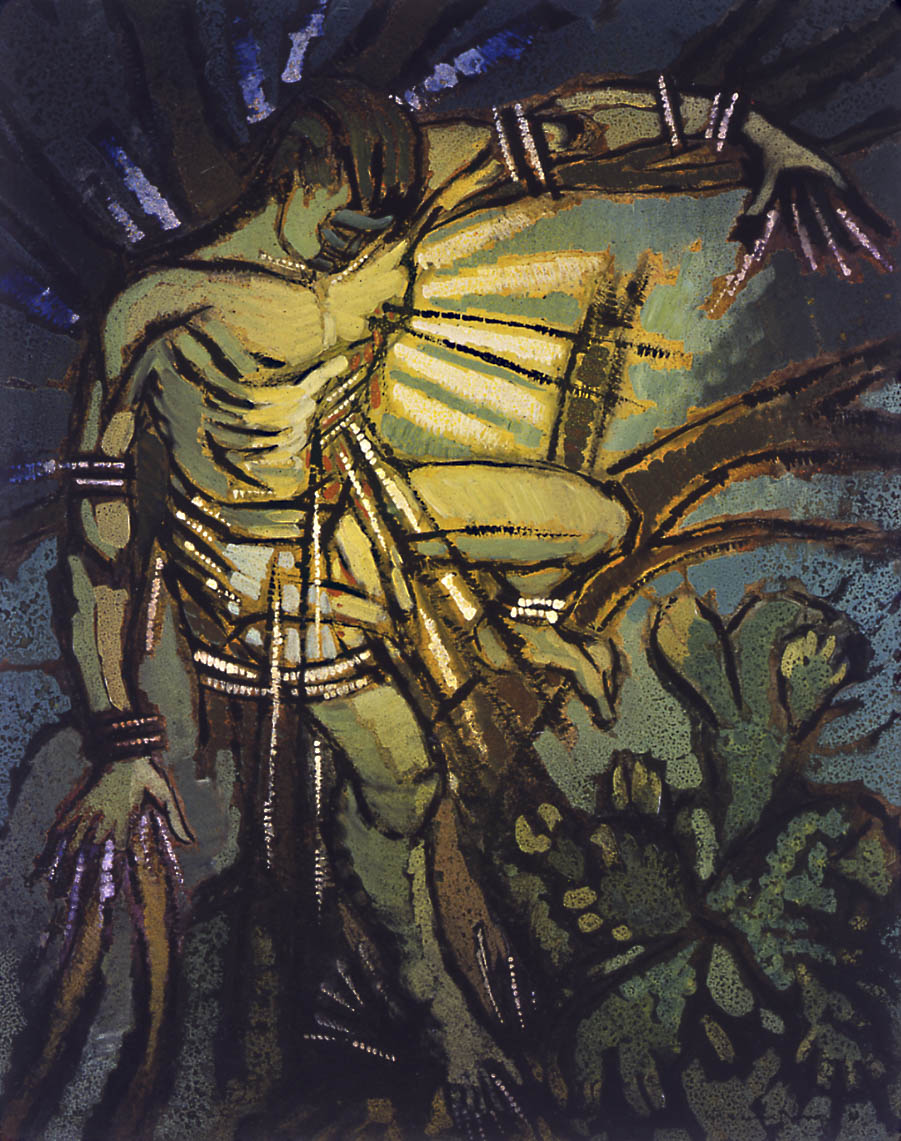
ohne Titel, Nr. 009, Öl auf Leinwand, 100 x 79 cm
and maimed bodies are especially prominent. The traces of physical cruelty are plainly evident. This quality is especially drastic in the two paintings with figures tied to a tree or bamboo poles (cf. illustrations on p. 77 / no. 009 and p. 80 / no. 011). They depict people who suffer death for their religious beliefs. One of the martyrs is tied to a tree and pierced with luminous arrows. This is probably a representation of the martyrdom of Saint Sebastian. Sebastian was an officer in the Roman army and was sentenced to death by Emperor Diocletian because he publicly avowed his faith in Christianity. The second painting undoubtedly depicts Christ himself. The crown of thorns, the wound in the side, and the bloody wounds on the palms are unmistakable iconographic references to the passion of Christ. Christ’s gaze is turned upward and is focusing on something outside of the pictorial composition. As a result of this impetus, the reference to his imminent death is wholly penetrated by a redemptive moment.
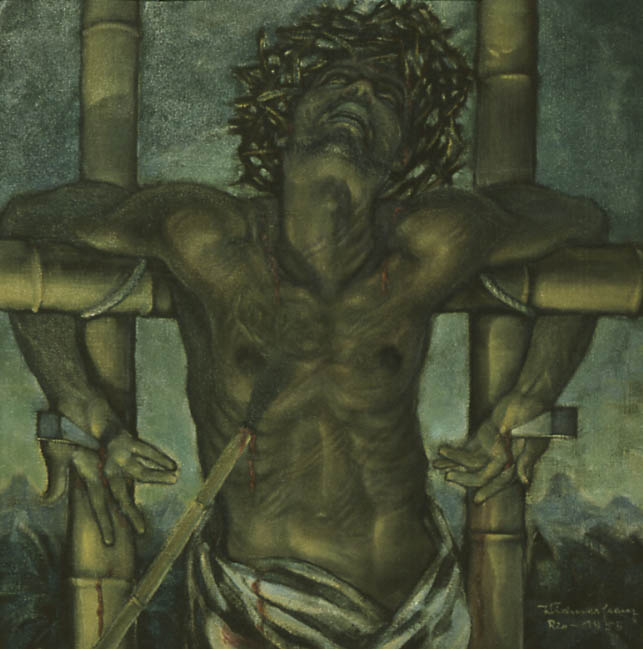
ohne Titel, 1955, Nr. 011, Öl auf Leinwand, 84 x 84 cm

ohne Titel, Nr. 300, Öl auf Leinwand, 200 x 70 cm
Another painting shows the Redeemer with a blessing gesture above a sea of followers. The painting is in pastel tones; the sun behind Christ’s head is the only place where black is used, and this device establishes a clear division from the soft colours in the rest of the composition. Despite its darkness, it creates a kind of luminous effect. Another picture shows the isolated head of Christ. Due to its blurred contours and the soft browns that flow into each other, it conveys an iconic impression. This is further underscored by the mask-like, veiled facial expression evoking a distanced and dignified serenity. A direct allusion to the veil of Veronica, and hence to the actual origins of icon painting, can easily be read into the painting. Legend has it that Veronica gave her cloth to Jesus as he headed to Golgatha, where he was to be crucified, so that he could wipe the sweat and blood from his face. An impression of his face miraculously appeared on the cloth.
Overall, the religious paintings of Franz Widmar are dominated by the subject of Christ and martyrdom. The question of what may have moved the artist to repeatedly take up this topic in his repertoire in the course of his career remains unanswered.
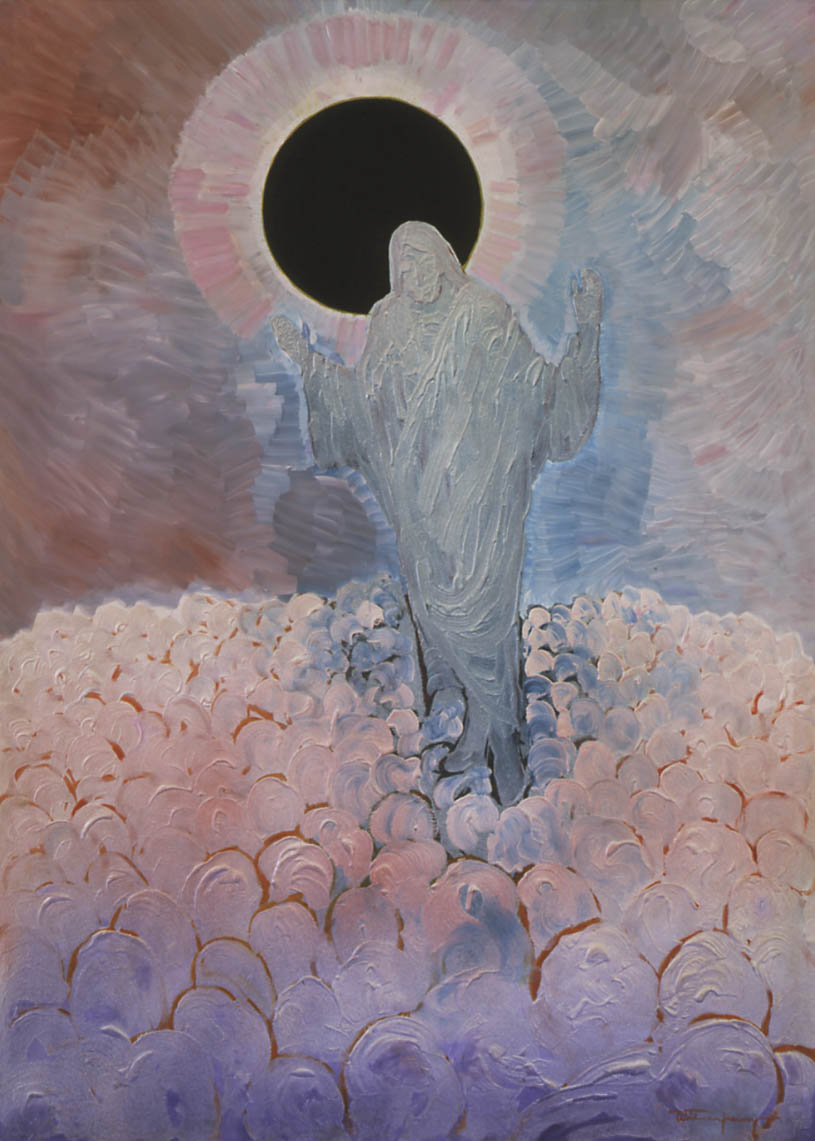
ohne Titel, Nr. 296, Öl auf Leinwand, 170.5 x 122.5 cm
